

What does a "good" outline look like? What does a full-sentence outline look like? How do I create one?
An outline is a tool used to organize written ideas about a topic or thesis into a logical order. Outlines arrange major topics, subtopics, and supporting details. Writers use outlines when writing their papers in order to know which topic to cover in what order. Outlines for papers can be very general or very detailed. Check with your instructor to know which is expected of you. Here are some examples of different outlines. You can also learn more by watching the short video below .
The most common type of outline is an alphanumeric outline , or an outline that uses letters and numbers in the following order:
I. Roman Numerals
A. I, II, III, IV, V, VI, VII, VIII, IX, X, etc.
B. Represent main ideas to be covered in the paper in the order they will be presented
II. Uppercase Letters
A. A, B, C, D, E, F, G, H, I, J, K, L, etc.
B. Represent subtopics within each main idea
III. Arabic Numbers
A. 1, 2, 3, 4, 5, 6, 7, 8, 9, 10, etc.
B. Represent details or subdivisions within subtopics
IV. Lowercase Letters
A. a, b, c, d, e, f, g, h, i, j, l, m, etc.
B. Represent details within subdivisions
Outline with main ideas, subtopics, subdivisions and details :
Thesis: Drugs should be legalized.
I. Legalization of drugs would reduce crime rates
A. Prohibition
1. Before Prohibition, crime rate related to alcohol were low-to-medium
2. During Prohibition, crime rates related to alcohol were high
a. Arrests for drunkenness and disorderly conduct increase 41%
b. Federal prison population increased 366%
3. After Prohibition, crime rates related to alcohol were very low
B. Amsterdam/Netherlands
1. Before Amsterdam had legalized marijuana, drug-related crime rates were high
2. After Amsterdam had legalized marijuana, drug-related crime rates dropped
II. Legalization of drugs would benefit the economy
1. Local taxes
2. State taxes
3. Federal taxes
B. Business Owners
1. Drug production
2. Drug quality testing
3. Drug sales
III. Legalization of drugs would benefit public health
A. Quality of drugs would increase
1. Fake/dangerous drugs eliminated
2. Fake/placebo drugs eliminated
3. Amount of active ingredient standardized and stabilized
B. Drug users with addiction issues would get more help
1. Hospitals
3. Public health clinics
C. Your people would be less likely to start drugs
F ull-sentence outline :
- Each roman numeral (I, II, III, IV…) indicates the start of a new paragraph. So I. is the first sentence of the introduction, II. is the first sentence of the first paragraph of the body, III. is the first sentence of the second paragraph of the body, and so on.
- Each capital letter (A, B, C, D…) indicates a main point within the structure of the paragraph. So in our introduction, A. is the attention getter, B. is another attention getter, C. describes a point that makes the topic personal, and D. is the thesis statement.
- Each Arabic numeral (1, 2, 3, 4…) indicates a sentence or piece of supporting evidence for each main point. So in the first body paragraph (II.), point A. is a general statement that needs some additional support, so 1. provides a supporting statement of fact and the citation of where that information came from. 2. provides another sentence with supporting evidence, as does 3.
Example of a full-sentence outline:
Warming Our World and Chilling Our Future
Thesis Statement: Today I want to share what I have learned about global warming and its causes.
I. Global warming is alive and well and thriving in Antarctica.
A. In winter 1995, an iceberg the size of Rhode Island broke off.
B. In October 1998, an iceberg the size of Delaware broke off.
C. All of us have a lot at stake.
1. Now, I am what you call a “country mouse.”
2. I love the outdoors.
3. You can be a “city mouse,” and like clean air, good water, and not having to worry about sun.
D. Today I want to share what I have learned about global warming and its causes.
II. Global warming is a gradual warming of the Earth from human activities (citation).
A. It is characterized by a high concentration of carbon dioxide in the atmosphere.
1. Each year five tons of CO2 are pumped into the atmosphere (citation).
2. The carbon dioxide traps heat.
3. 1998 set temperature records (citation).
B. Carbon pollutants also eat a hole in the ozone layer (citation).
1. In 1998 this hole set a size record.
2. This allows more ultraviolet radiation to reach Earth.
C. If this problem is not corrected; we may see disastrous results (citation).
1. There could be dramatic climate changes.
a. There could be drought in the middle of continents.
b. There could be many severe storms.
c. There could be rising sea levels that would destroy coastal areas.
2. There could be serious health problems.
a. There could be an increase in skin cancer.
b. There could be an increase in cataracts.
c. There could be damaged immune systems.
D. Now that you understand what global warming is and why it is important, let’s examine its major causes.
III. The loss of woodlands adds to global warming (citation). …..
IV. Industrial emissions accelerate global warming (citation). …..
V. Personal energy consumption magnifies global warming (citation). …..
VI. In conclusion, if you want to know why we have global warming, listen for the falling trees, watch the industrial smokestacks darkening the sky, and smell the exhaust fumes we are pumping into the air.
A. Gore told a story on how global warming can sneak up on us.
B. Addressing the National Academy of Sciences, the vice president said, “If dropped into a pot of boiling water….”
C. The more we know about global warming, the more likely we are to jump and the less likely we are to be cooked.
Links & Files
- Outline Template
- Reading and Writing
- Weekly Written Assignments
- Research Papers
- Last Updated Jul 27, 2022
- Views 720938
- Answered By Kerry Louvier
FAQ Actions
- Share on Facebook
Hello! We're here to help! Please log in to ask your question.
Need an answer now? Search our FAQs !
How can I find my course textbook?
You can expect a prompt response, Monday through Friday, 8:00 AM-4:00 PM Central Time (by the next business day on weekends and holidays).
Questions may be answered by a Librarian, Learning Services Coordinator, Instructor, or Tutor.
Purdue Online Writing Lab Purdue OWL® College of Liberal Arts
Types of Outlines and Samples

Welcome to the Purdue OWL
This page is brought to you by the OWL at Purdue University. When printing this page, you must include the entire legal notice.
Copyright ©1995-2018 by The Writing Lab & The OWL at Purdue and Purdue University. All rights reserved. This material may not be published, reproduced, broadcast, rewritten, or redistributed without permission. Use of this site constitutes acceptance of our terms and conditions of fair use.
Alphanumeric Outlines
This is the most common type of outline and usually instantly recognizable to most people. The formatting follows these characters, in this order:
- Roman Numerals
- Capitalized Letters
- Arabic Numerals
- Lowercase Letters
If the outline needs to subdivide beyond these divisions, use Arabic numerals inside parentheses and then lowercase letters inside parentheses. Select the "Sample Outlines" PDF in the Media Box above to download the sample of this outline.
The sample PDF in the Media Box above is an example of an outline that a student might create before writing an essay. In order to organize her thoughts and make sure that she has not forgotten any key points that she wants to address, she creates the outline as a framework for her essay.
What is the assignment?
Your instructor asks the class to write an expository (explanatory) essay on the typical steps a high school student would follow in order to apply to college.
What is the purpose of this essay?
To explain the process for applying to college
Who is the intended audience for this essay?
High school students intending to apply to college and their parents
What is the essay's thesis statement?
When applying to college, a student follows a certain process which includes choosing the right schools and preparing the application materials.
Full Sentence Outlines
The full sentence outline format is essentially the same as the Alphanumeric outline. The main difference (as the title suggests) is that full sentences are required at each level of the outline. This outline is most often used when preparing a traditional essay. Select the "Sample Outlines" PDF in the Media Box above to download the sample of this outline.
Decimal Outlines
The decimal outline is similar in format to the alphanumeric outline. The added benefit is a system of decimal notation that clearly shows how every level of the outline relates to the larger whole. Select the "Sample Outlines" PDF in the Media Box above to download the sample of this outline.
Essay Writing Guide
Essay Outline
Last updated on: Jun 28, 2024
A Complete Essay Outline - Guidelines and Format
By: Nova A.
13 min read
Reviewed By: Melisa C.
Published on: Jan 15, 2019

To write an effective essay, you need to create a clear and well-organized essay outline. An essay outline will shape the essay’s entire content and determine how successful the essay will be.
In this blog post, we'll be going over the basics of essay outlines and provide a template for you to follow. We will also include a few examples so that you can get an idea about how these outlines look when they are put into practice.
Essay writing is not easy, but it becomes much easier with time, practice, and a detailed essay writing guide. Once you have developed your outline, everything else will come together more smoothly.
The key to success in any area is preparation - take the time now to develop a solid outline and then write your essays!
So, let’s get started!
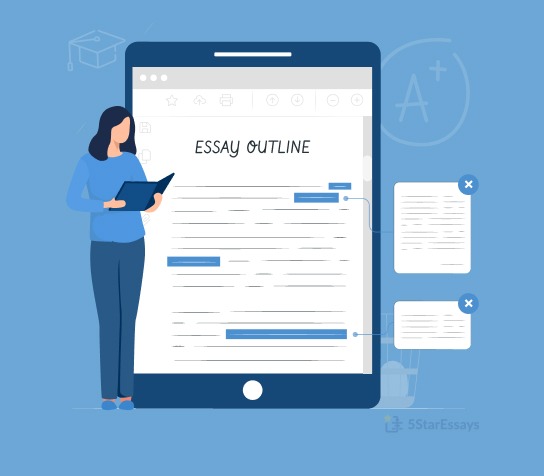
On this Page
What is an Essay Outline?
An essay outline is your essay plan and a roadmap to essay writing. It is the structure of an essay you are about to write. It includes all the main points you have to discuss in each section along with the thesis statement.
Like every house has a map before it is constructed, the same is the importance of an essay outline. You can write an essay without crafting an outline, but you may miss essential information, and it is more time-consuming.
Once the outline is created, there is no chance of missing any important information. Also, it will help you to:
- Organize your thoughts and ideas.
- Understand the information flow.
- Never miss any crucial information or reference.
- Finish your work faster.
These are the reasons if someone asks you why an essay outline is needed. Now there are some points that must be kept in mind before proceeding to craft an essay outline.

Easily Outline Your Essays In Seconds!
Prewriting Process of Essay Outline
Your teacher may ask you to submit your essay outline before your essay. Therefore, you must know the preliminary guidelines that are necessary before writing an essay outline.
Here are the guidelines:
- You must go through your assignments’ guidelines carefully.
- Understand the purpose of your assignment.
- Know your audience.
- Mark the important point while researching your topic data.
- Select the structure of your essay outline; whether you are going to use a decimal point bullet or a simple one.

Paper Due? Why Suffer? That's our Job!
How to Write an Essay Outline in 4 Steps
Creating an essay outline is a crucial step in crafting a well-structured and organized piece of writing. Follow these four simple steps to create an effective outline:
Step 1: Understand the Topic
To begin, thoroughly grasp the essence of your essay topic.
Break it down into its key components and identify the main ideas you want to convey. This step ensures you have a clear direction and focus for your essay.
Step 2: Brainstorm and Gather Ideas
Let your creativity flow and brainstorm ideas related to your topic.
Jot down key pieces of information, arguments, and supporting evidence that will strengthen your essay's overall message. Consider different perspectives and potential counterarguments to make your essay well-rounded.
Step 3: Organize Your Thoughts
Now it's time to give structure to your ideas.
Arrange your main points in a logical order, starting with an attention-grabbing introduction, followed by body paragraphs that present your arguments.
Finally, tie everything together with a compelling conclusion. Remember to use transitional phrases to create smooth transitions between sections.
Step 4: Add Depth with Subpoints
To add depth and clarity to your essay, incorporate subpoints under each main point.
These subpoints provide more specific details, evidence, or examples that support your main ideas. They help to further strengthen your arguments and make your essay more convincing.
By following these four steps - you'll be well on your way to creating a clear and compelling essay outline.
Essay Outline Format
It is an easy way for you to write your thoughts in an organized manner. It may seem unnecessary and unimportant, but it is not.
It is one of the most crucial steps for essay writing as it shapes your entire essay and aids the writing process.
An essay outline consists of three main parts:
1. Introduction
The introduction body of your essay should be attention-grabbing. It should be written in such a manner that it attracts the reader’s interest. It should also provide background information about the topic for the readers.
You can use a dramatic tone to grab readers’ attention, but it should connect the audience to your thesis statement.
Here are some points without which your introduction paragraph is incomplete.
To attract the reader with the first few opening lines, we use a hook statement. It helps engage the reader and motivates them to read further. There are different types of hook sentences ranging from quotes, rhetorical questions to anecdotes and statistics, and much more.
Are you struggling to come up with an interesting hook? View these hook examples to get inspired!
A thesis statement is stated at the end of your introduction. It is the most important statement of your entire essay. It summarizes the purpose of the essay in one sentence.
The thesis statement tells the readers about the main theme of the essay, and it must be strong and clear. It holds the entire crux of your essay.
Need help creating a strong thesis statement? Check out this guide on thesis statements and learn to write a statement that perfectly captures your main argument!
2. Body Paragraphs
The body paragraphs of an essay are where all the details and evidence come into play. This is where you dive deep into the argument, providing explanations and supporting your ideas with solid evidence.
If you're writing a persuasive essay, these paragraphs will be the powerhouse that convinces your readers. Similarly, in an argumentative essay, your body paragraphs will work their magic to sway your audience to your side.
Each paragraph should have a topic sentence and no more than one idea. A topic sentence is the crux of the contents of your paragraph. It is essential to keep your reader interested in the essay.
The topic sentence is followed by the supporting points and opinions, which are then justified with strong evidence.
3. Conclusion
When it comes to wrapping up your essay, never underestimate the power of a strong conclusion. Just like the introduction and body paragraphs, the conclusion plays a vital role in providing a sense of closure to your topic.
To craft an impactful conclusion, it's crucial to summarize the key points discussed in the introduction and body paragraphs. You want to remind your readers of the important information you shared earlier. But keep it concise and to the point. Short, powerful sentences will leave a lasting impression.
Remember, your conclusion shouldn't drag on. Instead, restate your thesis statement and the supporting points you mentioned earlier. And here's a pro tip: go the extra mile and suggest a course of action. It leaves your readers with something to ponder or reflect on.
5 Paragraph Essay Outline Structure
An outline is an essential part of the writing as it helps the writer stay focused. A typical 5 paragraph essay outline example is shown here. This includes:
- State the topic
- Thesis statement
- Introduction
- Explanation
- A conclusion that ties to the thesis
- Summary of the essay
- Restate the thesis statement
Tough Essay Due? Hire Tough Writers!
Essay Outline Template
The outline of the essay is the skeleton that you will fill out with the content. Both outline and relevant content are important for a good essay. The content you will add to flesh out the outline should be credible, relevant, and interesting.
The outline structure for the essay is not complex or difficult. No matter which type of essay you write, you either use an alphanumeric structure or a decimal structure for the outline.
Below is an outline sample that you can easily follow for your essay.
Essay Outline Sample
Essay Outline Examples
An essay outline template should follow when you start writing the essay. Every writer should learn how to write an outline for every type of essay and research paper.
Essay outline 4th grade
Essay outline 5th grade
Essay outline high school
Essay outline college
Given below are essay outline examples for different types of essay writing.
Argumentative Essay Outline
An argumentative essay is a type of essay that shows both sides of the topic that you are exploring. The argument that presents the basis of the essay should be created by providing evidence and supporting details.
Persuasive Essay Outline
A persuasive essay is similar to an argumentative essay. Your job is to provide facts and details to create the argument. In a persuasive essay, you convince your readers of your point of view.
Compare and Contrast Essay Outline
A compare and contrast essay explains the similarities and differences between two things. While comparing, you should focus on the differences between two seemingly similar objects. While contrasting, you should focus on the similarities between two different objects.
Narrative Essay Outline
A narrative essay is written to share a story. Normally, a narrative essay is written from a personal point of view in an essay. The basic purpose of the narrative essay is to describe something creatively.
Expository Essay Outline
An expository essay is a type of essay that explains, analyzes, and illustrates something for the readers. An expository essay should be unbiased and entirely based on facts. Be sure to use academic resources for your research and cite your sources.
Analytical Essay Outline
An analytical essay is written to analyze the topic from a critical point of view. An analytical essay breaks down the content into different parts and explains the topic bit by bit.
Rhetorical Analysis Essay Outline
A rhetorical essay is written to examine the writer or artist’s work and develop a great essay. It also includes the discussion.
Cause and Effect Essay Outline
A cause and effect essay describes why something happens and examines the consequences of an occurrence or phenomenon. It is also a type of expository essay.
Informative Essay Outline
An informative essay is written to inform the audience about different objects, concepts, people, issues, etc.
The main purpose is to respond to the question with a detailed explanation and inform the target audience about the topic.
Synthesis Essay Outline
A synthesis essay requires the writer to describe a certain unique viewpoint about the issue or topic. Create a claim about the topic and use different sources and information to prove it.
Literary Analysis Essay Outline
A literary analysis essay is written to analyze and examine a novel, book, play, or any other piece of literature. The writer analyzes the different devices such as the ideas, characters, plot, theme, tone, etc., to deliver his message.
Definition Essay Outline
A definition essay requires students to pick a particular concept, term, or idea and define it in their own words and according to their understanding.
Descriptive Essay Outline
A descriptive essay is a type of essay written to describe a person, place, object, or event. The writer must describe the topic so that the reader can visualize it using their five senses.
Evaluation Essay Outline
Problem Solution Essay Outline
In a problem-solution essay, you are given a problem as a topic and you have to suggest multiple solutions on it.
Scholarship Essay Outline
A scholarship essay is required at the time of admission when you are applying for a scholarship. Scholarship essays must be written in a way that should stand alone to help you get a scholarship.
Reflective Essay Outline
A reflective essay is written to express your own thoughts and point of view regarding a specific topic.
Getting started on your essay? Give this comprehensive essay writing guide a read to make sure you write an effective essay!
With this complete guide, now you understand how to create an outline for your essay successfully. However, if you still can’t write an effective essay, then the best option is to consult a professional academic writing service.
Essay writing is a dull and boring task for some people. So why not get some help instead of wasting your time and effort? 5StarEssays.com is here to help you. All your do my essay for me requests are managed by professional essay writers.
Place your order now, and our team of expert academic writers will help you.
Frequently Asked Questions
What are the three types of outlines.
Here are the three types of essay outline;
- Working outline
- Speaking outline
- Full-sentence outline
All three types are different from each other and are used for different purposes.
What does a full-sentence outline look like?
A full sentence outline contains full sentences at each level of the essay’s outline. It is similar to an alphanumeric outline and it is a commonly used essay outline.
What is a traditional outline format?
A traditional essay outline begins with writing down all the important points in one place and listing them down and adding sub-topics to them. Besides, it will also include evidence and proof that you will use to back your arguments.
What is the benefit of using a traditional outline format and an informal outline format?
A traditional outline format helps the students in listing down all the important details in one palace while an informal outline will help you coming up with new ideas and highlighting important points

As a Digital Content Strategist, Nova Allison has eight years of experience in writing both technical and scientific content. With a focus on developing online content plans that engage audiences, Nova strives to write pieces that are not only informative but captivating as well.
Was This Blog Helpful?
Keep reading.
- How to Write an Essay - A Complete Guide with Examples

- The Art of Effective Writing: Thesis Statements Examples and Tips

- Writing a 500 Word Essay - Easy Guide

- What is a Topic Sentence - An Easy Guide with Writing Steps & Examples

- 220 Best Transition Words for Essays

- Essay Format: Detailed Writing Tips & Examples

- How to Write a Conclusion - Examples & Tips

- Essay Topics: 100+ Best Essay Topics for your Guidance

- How to Title an Essay: A Step-by-Step Guide for Effective Titles

- How to Write a Perfect 1000 Word Essay

- How To Make An Essay Longer - Easy Guide For Beginners

- Learn How to Start an Essay Effectively with Easy Guidelines

- Types of Sentences With Examples

- Hook Examples: How to Start Your Essay Effectively

- Essay Writing Tips - Essential Do’s and Don’ts to Craft Better Essays

- How To Write A Thesis Statement - A Step by Step Guide

- Art Topics - 200+ Brilliant Ideas to Begin With

- Writing Conventions and Tips for College Students

Say Goodbye to Academic Stress!
With FREE AI report, Turnitin report, bibliography, title page, and a lot more!
LIMITED TIME ONLY
People Also Read
- how to write a research methodology
- annotated bibliography topics
- how to cite a research paper
- literary analysis essay topics
- personal statement examples
Burdened With Assignments?

Advertisement
OFFER EXPIRES SOON!
© 2024 - All rights reserved
How to Write an Essay Outline with Step-by-Step Instructions

Mark Bradford
An essay outline is like a plan for your writing before you start putting words on paper. It helps you organize your thoughts by summarizing the main points for each paragraph. This way, you can see how your argument will unfold.
Sometimes, your assignment might specifically ask for an outline before you begin writing. But even if it's not required, making an outline is a good practice. It helps you structure your ideas and gives you a clear roadmap for your writing process.
By breaking down each paragraph into brief summaries of the points you want to cover, you ensure that your essay will have a logical flow. This makes it easier for your readers to follow your argument. Additionally, creating an outline allows you to assess the coherence and relevance of each point, helping you identify and address any weak spots in your argument early on.
In essence, think of writing an essay outline as a practical tool for better organization and refining your ideas. It's a useful step that can make your writing process smoother and your final essay more compelling. If you're pressed for time or need additional assistance, you can pay for essay services to lighten your workload and ensure a polished end result.
How to Organize an Essay Outline in 2 Steps
Writing a college essay outline effectively is like creating a roadmap for your thoughts. It not only helps you stay on track but also ensures your ideas unfold in a logical and coherent manner. According to our online essay writing service , two crucial steps in this process are establishing classifications and arranging data.
.png)
Establishing Classifications
When considering how to make a topic outline, begin by categorizing your primary ideas into distinct classifications. This categorization serves as the structural backbone of your essay, allowing you to identify common themes or topics that naturally align. For instance, imagine you're writing about the benefits of technology in education. Your classifications could include categories such as improved accessibility, enhanced collaboration, and personalized learning. By doing this, you create a roadmap that guides your discussion and helps maintain a clear focus for each section.
Consider, too, the diverse landscape of essay formats . Depending on the type of essay you're crafting, whether it's persuasive, informative, or analytical, the format can influence how you structure your outline. Recognizing the nuances of various essay formats ensures that your outline aligns seamlessly with the requirements of your chosen genre, enhancing the overall coherence and effectiveness of your writing.
Furthermore, seeking essay outline help can be valuable at this stage. Whether it's from a teacher, tutor, or online resources, getting assistance in organizing your thoughts and refining your outline can provide valuable insights.
Arrangement of Data
Once your classifications are in place, the next step is to carefully arrange the supporting details within each category. Picture this as assembling the pieces of a puzzle to form a cohesive picture. Consider the logical flow of information – arrange your details in a way that makes the most sense for your reader to grasp your argument. Going back to our technology in education example, under the classification of improved accessibility, you might discuss the impact of online resources, digital textbooks, and e-learning platforms. This deliberate arrangement ensures a smooth transition from one idea to the next, guiding your reader through your essay seamlessly and mastering the art of how to write an academic essay .

Essay Structure Outline
In this section, we'll look at the five paragraph essay outline and how each paragraph centers around one idea supporting your main topic. You'll use evidence or analysis to expand on each point.
The typical outline format will present these points in short, numbered sentences or phrases, with the option to add sub-points for more detail. See the template below for a straightforward structure suited for a five paragraph essay outline example.
.png)
I. Introduction
- Hook/Opening statement
- Background information
- Thesis statement
II. Body Paragraphs
- Paragraph 1:
- Topic sentence
- Supporting detail 1
- Supporting detail 2
- Transition to the next paragraph
- Paragraph 2:
- Continue this pattern for additional paragraphs
III. Counterargument/Refutation (if applicable)
- Counterargument
- Transition to the next section
IV. Conclusion
- Summary of main points
- Restate thesis
- Closing remarks or call to action
V. References/Bibliography (if required)
Essay Outline Examples
In the following sections, we'll explore practical examples of outlines to guide you through the structuring process. Let's delve into each to understand their distinct structures and purposes.
Argumentative Essay Outline
This outline is designed for essays where you aim to persuade your audience to adopt a specific stance or viewpoint. It typically comprises:
Introduction:
Body Paragraphs:
- Each paragraph presents a distinct supporting argument.
- Supporting evidence or analysis
- Counterargument and refutation (if applicable)
Conclusion:
- Recap of main points
- Restatement of thesis
Expository Essay Outline
This outline is suitable for essays that aim to inform or explain a particular topic. It generally follows this structure:

- Each paragraph explores a specific aspect or subtopic.
- Supporting evidence or examples
- Final thoughts or implications
College Admissions Essay Outline
Crafting a compelling college admissions essay requires a thoughtful approach to showcase your unique qualities and experiences. Here's a comprehensive outline tailored for this specific essay type:
- Personal Hook: Capture the reader's attention with a personal anecdote, quote, or question.
- Background Information: Provide context about your educational goals, aspirations, or experiences.
- Thesis Statement: Clearly state the overarching theme or message you aim to convey.
- Paragraph 1 - Academic Achievements and Goals:
- Highlight key academic accomplishments.
- Discuss your academic aspirations and how the college aligns with them.
- Paragraph 2 - Extracurricular Involvement:
- Detail significant extracurricular activities, showcasing leadership and impact.
- Connect your extracurricular experiences to your personal growth.
- Paragraph 3 - Personal Challenges and Growth:
- Share personal challenges you've overcome.
- Emphasize lessons learned and personal growth.
- Paragraph 4 - Unique Qualities and Perspectives:
- Showcase your unique qualities, skills, or perspectives.
- Explain how these contribute to the college community.
- Reiteration of Fit: Reinforce why you are an ideal fit for the college.
- Reflection on Journey: Reflect on your academic and personal journey.
- Closing Thoughts: End with a strong and memorable statement.
Literary Analysis Essay Outline
Analyzing a piece of literature requires a systematic approach to uncover its deeper meanings and literary elements. Here's a detailed outline:
- Hook: Engage the reader with a captivating introduction related to the literary work.
- Context: Provide necessary background information about the author, time period, or cultural context.
- Thesis Statement: Clearly state the main point of your analysis, focusing on a specific aspect of the literary work.
- Paragraph 1 - Introduction to Literary Elements:
- Introduce and define the primary literary elements (such as theme, character, or setting) to be analyzed.
- Provide brief examples or evidence from the text.
- Paragraphs 2-4 - In-Depth Analysis of Literary Elements:
- Dedicate each paragraph to a specific literary element.
- Analyze how each element contributes to the overall meaning or theme.
- Provide evidence from the text to support your analysis.
- Paragraph 5 - Exploration of Symbolism or Imagery:
- Discuss any symbolic elements or recurring imagery in the literary work.
- Explore the deeper meanings behind these symbols.
- Summarize Key Points: Recap the main findings from each body paragraph.
- Restate Thesis: Reaffirm the main argument of your analysis.
- Final Thoughts: Provide broader insights into the significance of your analysis and its implications.
Persuasive Essay Outline
In persuasive essays, the goal is to convince the reader of a particular viewpoint or to prompt action. Here's an effective outline for structuring this type of essay:

- Hook: Capture the reader's attention with a compelling statement, fact, or question.
- Background Information: Provide context about the issue or topic.
- Thesis Statement: Clearly state your stance and the main points supporting your argument.
- Paragraph 1 - Strongest Argument:
- Present your most compelling argument.
- Support it with evidence, examples, or statistics.
- Address potential counterarguments.
- Paragraph 2 - Supporting Argument:
- Introduce a secondary argument supporting your thesis.
- Provide evidence and explain its relevance.
- Discuss counterarguments and refute them.
- Paragraph 3 - Additional Supporting Argument or Counterargument:
- Introduce another supporting argument or address a counterargument.
- Strengthen your position with evidence and reasoning.
Counterargument and Rebuttal:
- Address Counterarguments:
- Acknowledge opposing viewpoints.
- Present counterarguments to anticipate and address objections.
- Refute counterarguments with strong evidence or reasoning.
- Reinforce the superiority of your position.
- Summarize Main Points: Recap the key arguments presented in the body paragraphs.
- Restate Thesis: Reaffirm your stance on the issue.
- Call to Action or Closing Thoughts: Encourage the reader to take a specific action or leave them with a thought-provoking statement.
Personal Essay Outline
A personal essay provides a platform to express personal experiences, reflections, and insights. Here's an outline to help structure your personal essay:
- Hook: Start with a captivating anecdote, quote, or personal reflection.
- Background: Briefly introduce the central theme or topic of your personal essay.
- Thesis Statement: Clearly state the overarching message or lesson you want to convey.
- Paragraph 1 - Starting Point or Background:
- Share the initial circumstances or background of your narrative.
- Set the stage for the unfolding story.
- Paragraphs 2-4 - Key Moments or Reflections:
- Dedicate each paragraph to a significant moment or reflection.
- Describe events, emotions, and personal growth.
- Connect each to the overarching theme.
- Paragraph 5 - Resolution or Turning Point:
- Describe the turning point or resolution of your narrative.
- Reflect on how it impacted you or shaped your perspective.
Reflection and Insights:
- Personal Growth: Reflect on how the experiences described influenced your personal growth.
- Lessons Learned: Share insights or lessons learned from the narrative.
- Connection to Thesis: Reinforce how your personal story aligns with the thesis statement.
- Summarize Journey: Recap the main events or reflections discussed in the body paragraphs.
- Restate Thesis: Reaffirm the central message or lesson of your personal essay.
- Closing Thoughts: End with a powerful statement, reflection, or call to action.

Can I Seek Special Essay Outline Help?
What is the standard outline format, how do you write a college essay outline, how do i write an outline for an essay, what is an essay outline, at what point should i develop an outline essay.
Mark Bradford , a passionate and talented artist, utilizes his innovative spirit to support academic pursuits. In partnering with EssayHub, he leverages his artistic insights to assist students as a professional essay writer, helping them navigate and complete their academic assignments at every level of difficulty.

- Plagiarism Report
- Unlimited Revisions
- 24/7 Support
How to Write an Essay Outline: An Ultimate Guide
Table of contents
- 1.1 Introduction
- 1.2 Body paragraphs
- 1.3 Conclusion
- 2.1 Alphanumeric structure style
- 2.2 Decimal structure style
- 3 Steps to Creating an Outline for an Essay With a Thesis Statement
- 4 Tips for a Successful Outline
- 5.1 Template for Narrative Writing
- 5.2 Template of Argumentative Essay Outline
- 5.3 Template of Compare and Contrast Essay Outline
- 5.4 Template of Admission Essay Outline
- 6 Benefits of the Essay Outline in the Writing Process
- 7 Elevate Your Essay Writing with Outline
Have you ever felt like your thoughts are all over the place when you write an essay, or do you just want to make the essay writing a breeze? Well, you have hit the right spot!
This article will break down how to write an essay outline into simple, easy-to-follow steps. No more staring at a blank page, wondering what an essay outline is or how to write it.
With well-structured writing and a clear thesis statement, you will have a roadmap to navigate your essay, keeping your writing process on point.
Here is a sneak peek of what we will cover in this article:
- After reading this article, you will understand the importance of essay outline;
- You will learn about the essential outline parts;
- Understanding various types of outlines is crucial for creating a well-structured essay.
Whether you are an experienced essay writer looking to level up your game or a newbie trying to score big on your first big assignment, this essay writing guide has covered you.
Essential Parts of Essay Outline
Writing an effective outline for essay writing can be like baking a cake without a recipe. You know you want a delicious result, but things can get messy without understanding the key components. You need full sentences that make sense. Then, you require a thesis statement and introduction, and you must mix them in order.
Similarly, many struggle because they do not fully grasp the significance of body paragraphs and how to handle them effectively. Here is a template for a basic essay outline :
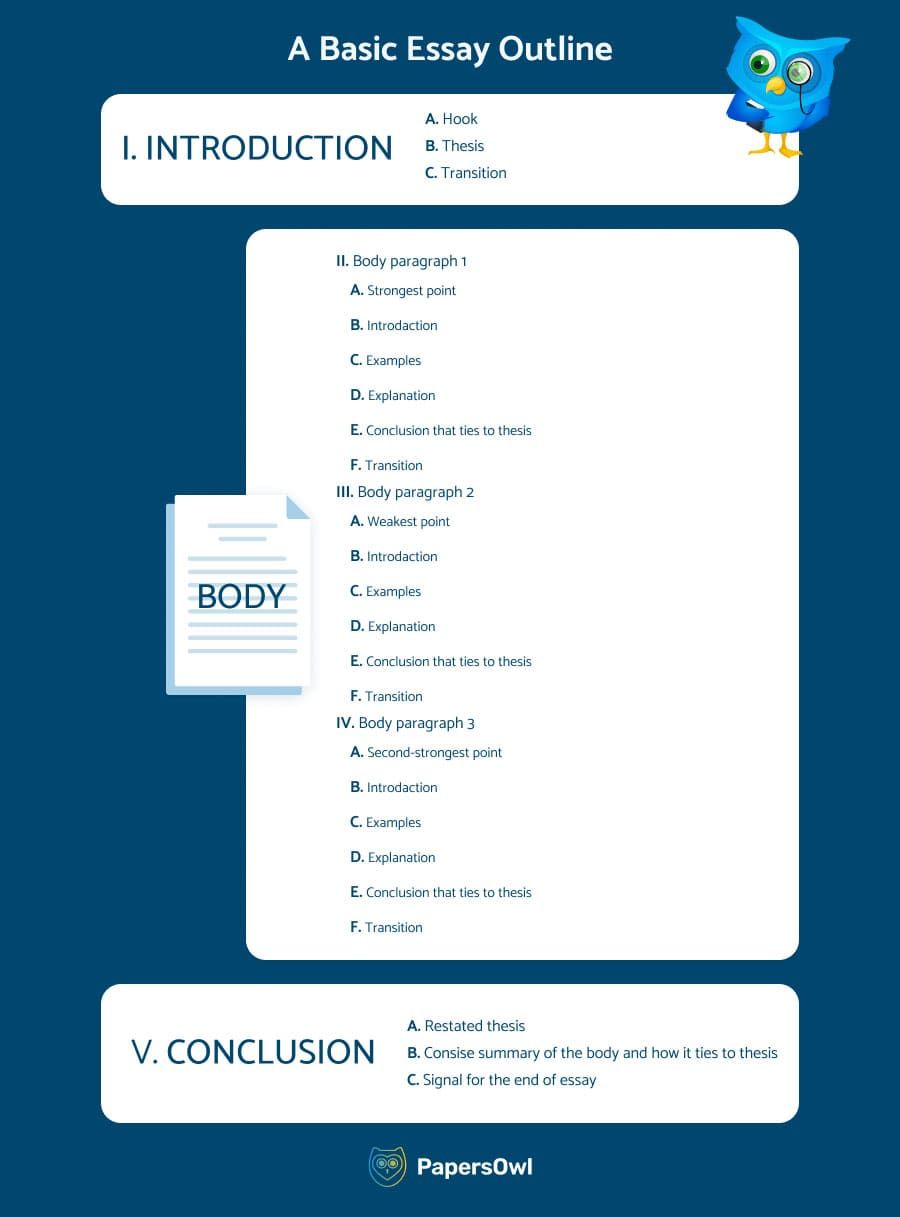
Introduction
The introduction is like the opening act in your standard essay outline structure. While many might think it requires a concise summary, it differs from how you should write your introduction. Firstly, the conclusion should have the hook statement of the thesis.
The introduction of a stellar assignment should start with an engaging hook to grab your reader’s attention, provide some background information to set the stage, and end with a crisp and concise thesis statement that tells your reader what to expect in the main body of your writing.
An introduction is the writer’s chance to make a solid first impression and set the tone for the rest of the writing. Following this approach will leave your readers wanting to read more essay outline examples!
Body paragraphs
In the structure, the body parts of an essay are like the heart of your writing. Instead of filling it with meaningless information, you should focus on delving into your thesis statement, providing examples, supporting points, and evidence to support your arguments. This is especially true for persuasive essays.
The main points are the big ideas you want to explore in your body paragraphs. They will act as topic sentences ─ the guiding stars or key arguments ─ keeping your writing on track and your reader engaged. Talk about the lessons learned and think about a smooth transition before you move to the next paragraph. It will help your reader understand and address counterarguments, if there are any!
In the context of a five-paragraph essay , your body paragraphs play a crucial role. Each body paragraph should focus on a main idea introduced in the opening or topic sentence. Afterward, you should include supporting points such as facts, quotes, anecdotes, or explanations to provide depth and context to your main idea. Try to use full sentences with a clear focus.
Ultimately, you can incorporate real-life instances and credible data to strengthen your arguments further, adding credibility and persuasiveness to your introduction and the main body paragraph. Your overall structure will improve, and you will use relevant information.
Remember to provide evidence for each fact and use one idea per paragraph. If you wish to add more detail or sub-points, use full sentences, not run-on examples.
The last part of your academic expository writing is the conclusion ─ it is like the grand finale of a fireworks show. It is your chance to bring your main point back into focus, like telling of personal growth.
However, instead of repeating your thesis word for word, it is better to restate it with a new perspective or a broader understanding, giving your readers a sense of closure.
Once you have restated your thesis, it is time to give your readers a quick recap. Summarize all the main points, reminding your readers of their incredible journey.
Finally, you must add your personal touch by sharing your final thoughts on the topic or a call to action if it is relevant. You can also add a few sensory aspects to evoke deep thoughts in the reader.
In your detailed essay outline format, the final paragraph of your paper is where you tie everything together. You revisit your thesis, summarize your main ideas, and leave your readers with food for thought.
Common Types
While it is all up to you to decide how to organize an outline, we advise you to ensure your essay outline adheres to the requirements provided along with the essay topic. You can choose the most convenient if there’s no required system for formatting the outline. Some are widely accepted. What are those types?
Alphanumeric structure style
The alphanumeric structure is the most frequent one. It features and follows these characters in the order of Roman numerals, Capital letters, Arabic numerals, and Lowercase letters.
Every subdivision is described as Roman numbers, and then you go with capital letters, Arabic numerals, and lowercase letters, accordingly.
- Roman numerals (I, II, III, etc.) to identify major sections of the outline. Usually, you will have five of them, each for every paragraph of the paper.
- Capital letters (A, B, C, etc.) appear to show points in the sections.
- Arabic numbers (1,2,3, etc.) are used for further important details.
- Lowercase letters (a,b,c, etc.) indicate if more details are needed.
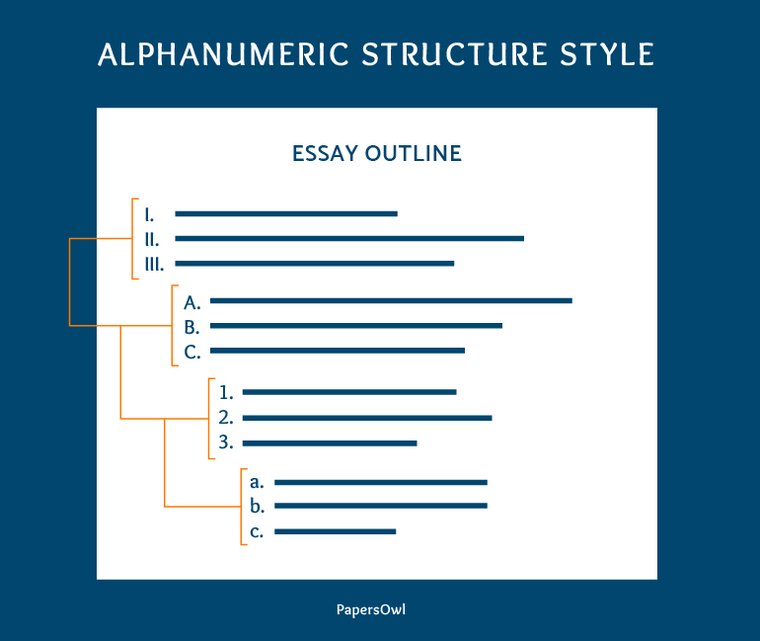
Decimal structure style
The decimal structure is similar to the alphanumeric structure but has one difference. Here we use only numerals. The added benefit of the decimal outline system relates to its decimal notation, which shows how every outline level relates to the main section.
Some people prefer this structure type because it might be easier to display the connection between each element.
- The outline begins with 1.0 and continues with 2.0, 3.0, etc. determining the beginning of every new section.
- For every new information point, we change the number after the dot. For instance, when we add information to the paragraph with the number 3.0, we name a new piece of information 3.1, 3.2, and so on.
- In case further details are needed, we add more decimals. In our case, it will look like 3.1.1, 3.2.1, etc.
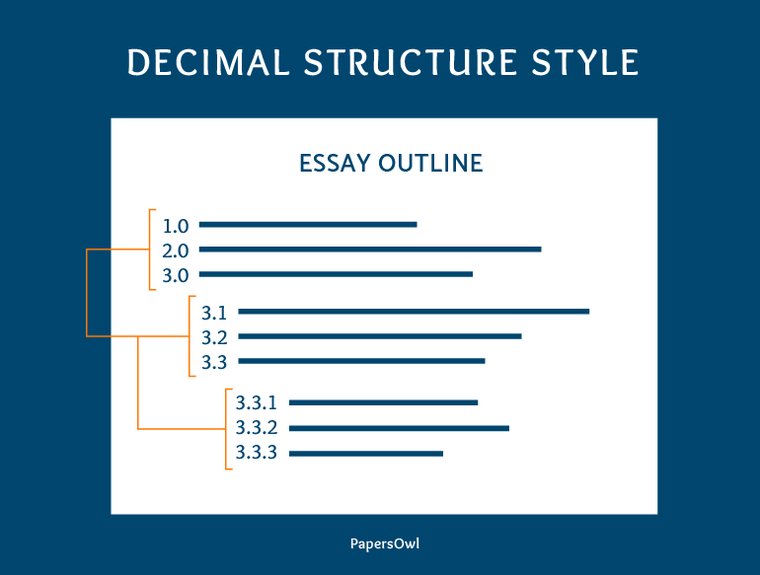
Steps to Creating an Outline for an Essay With a Thesis Statement
Learning how to write an essay outline is never easy! Each body paragraph must explain the thesis, especially in research papers where the logical flow is crucial!
It is not about following rigid rules but crafting a flexible framework that helps you express your ideas effectively. If it’s a literary analysis essay outline or something critical, following the rules comes first!
Do you often wonder who can “ write an essay for me ”? Following the steps mentioned below, you can create a stellar example and, as a result, write a well-structured paper on your own:
- Understand the Essay Prompt or Choose a Topic : Consider it the starting point of your work or your writing an MLA paper journey. You either have a prompt handed to you, or you get to pick your essay topic. If you have a prompt, make sure you fully understand it. If you’re choosing a topic, pick something that genuinely interests you, making the writing process much more enjoyable.
- Conduct Preliminary Research : Always do so before you write an essay outline! Gather sufficient information and evidence. Read the books or scroll on the internet to gather some preliminary research and provide supporting evidence. It will help you understand your topic better and get a general idea and a logical flow regarding what others have said.
- Identify the Main Argument and Supporting Ideas: Imagine you’re building the skeleton. Identify the central point to make your outline clear. It will be like the major bones, giving structure to your piece. A detailed outline is not necessary at this point. Once done, consider supporting ideas or arguments for the main point. These are like the smaller bones that provide strength and context.
- Arrange the Points in a Logical Order : Once you have the key points identified for your final essay, it is time to put them together in an organized manner to create a coherent structure, a critical aspect of constructing effective academic works. Think about the flow of your essay with all the supporting details. How should your primary ideas be arranged to ensure a smoother information flow? It is like assembling a puzzle ─ each piece should fit together seamlessly.
- Draft the Outline : In the end, you must start drafting things using your primary and supporting ideas. Use headings, subheadings, and bullet points to make it clear and organized. It will make your essay structure clearer and your writing process smoother. Your structure is your guide, so the choice is yours whether you want to make it a full-sentence outline (detailed) or a short-sentence (brief).
Tips for a Successful Outline
An effective essay example outline is like setting the stage for a well-organized and compelling work. Whether you are working on an expository, descriptive, or literary analysis essay outline, the right approach can make all the difference.
- Be Specific but Concise: Avoid unnecessary complexity and get straight to the point when outlining. The more specific you are about your essential points and supporting details, the more your outline will be more effective. Take it as trimming the fat off your writing ─ only the lean, meaningful topic sentence remains.
- Get Rid of the Fluff: Toss all the extra words and phrases that don’t add value to your research paper outline. Your outline should be free from unnecessary fluff. Removing it will make the essay outline simpler and more focused. When learning how to write an essay outline, you must include a basic argumentative essay outline and a good thesis statement that sums up the main points in the essay, which can do such a marvelous job. A college essay outline is your secret weapon for crafting clear, well-organized, and efficient essays.
- Use Bullet Points for Clarity: Remember, bullet points are your friends when outlining. They break down your ideas into bite-sized pieces, making your outline easy to skim and understand. It is like using road signs to navigate through your outline structure.
- Maintain a Consistent Structure: Keep things tidy and consistent. If you make an alphanumeric outline with Roman numerals for the main points, stick with them throughout. The same goes for subheadings and bullet points. Consistency in your alphanumeric format makes your outline easy on the eyes and brain.
- Revise and Adjust as Necessary: Feel free to revise and adjust as you go along. If a new idea pops up, incorporate it. If a section doesn’t seem to fit, reorganize. Keep refining your outline until it meets your satisfaction.
By following these tips, you can create an outline for an essay. With all the strategies mentioned above, you are well-equipped to craft a successful outline.
Examples and Templates of Various Essay Outlines
Crafting an essay can sometimes feel daunting, and sometimes you need to ask PapersOwl for help . That’s where the essay outline template comes in handy. It is like a trusty guide tailored for different essay types . Each template will serve as a roadmap, ensuring your essay is well-structured. Whether you share a personal story, build a persuasive argument, or aim for your dream school, we have covered you with these templates.
Let’s discuss each one and see how they work wonders:
Template for Narrative Writing
Imagine this as a storytelling guide. In a narrative essay, you are sharing a personal story or experience. Your outline should include sections for the introduction, plot development, characters, setting, climax, and conclusion. It is like mapping out the chapters of your own life’s story.
A narrative essay is a piece of writing that tells a story about an event on something creatively. It is similar to telling a personal story, a fiction narrative, or a literacy narrative essay. It is the least complicated kind of writing because you don’t have to perform any research. The most common topic for such an essay would be “How I spent my summer vacation.” The narrative essay has to be engaging. To do so, you have to:
- Conduct a thrilling plot.
- Include a conflict (i.e., a protagonist and an antagonist).
- Make bright characters.
- Exaggerate descriptions, but do not lie.
Using your imagination is one of the best strategies for entertaining your writing. Let it fill your essay with details and language to make your story come alive. Describe smells, emotions, feelings, and so on. However, remember that, in most cases, narrative essays are real stories.
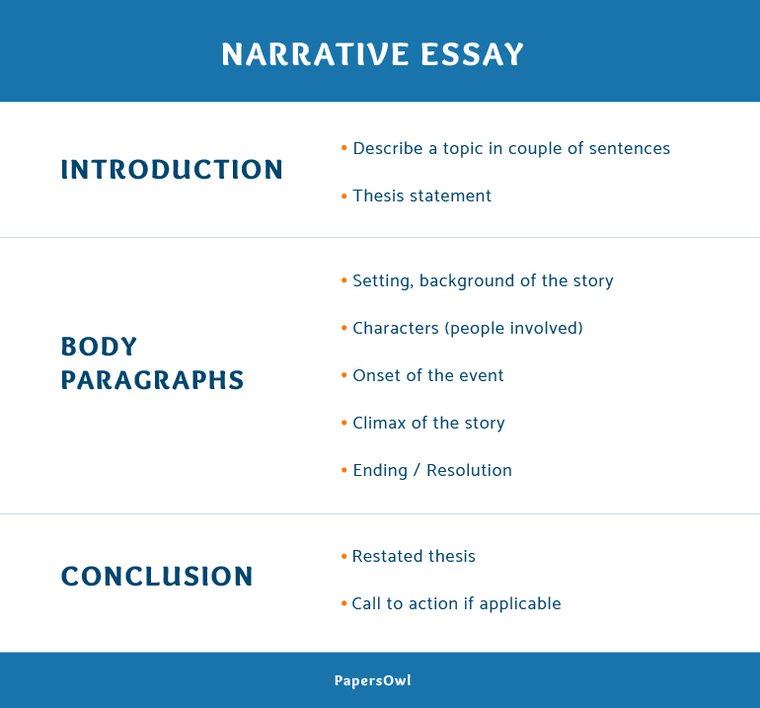
Template of Argumentative Essay Outline
An argumentative essay outline presents a clear stance and supports it with evidence. Your outline should have sections for the introduction, thesis statement, main arguments with supporting evidence, counterarguments, and a strong conclusion.
When writing such an essay, remember to:
- Pick a topic you are interested in (the reader will always notice your disinterest).
- Provide good arguments (be concrete).
- Research as much as possible (surprise your reader with new facts).
When working on your argument, collect valuable sources such as scientific magazines, academic journals, documentaries, newspapers, etc.
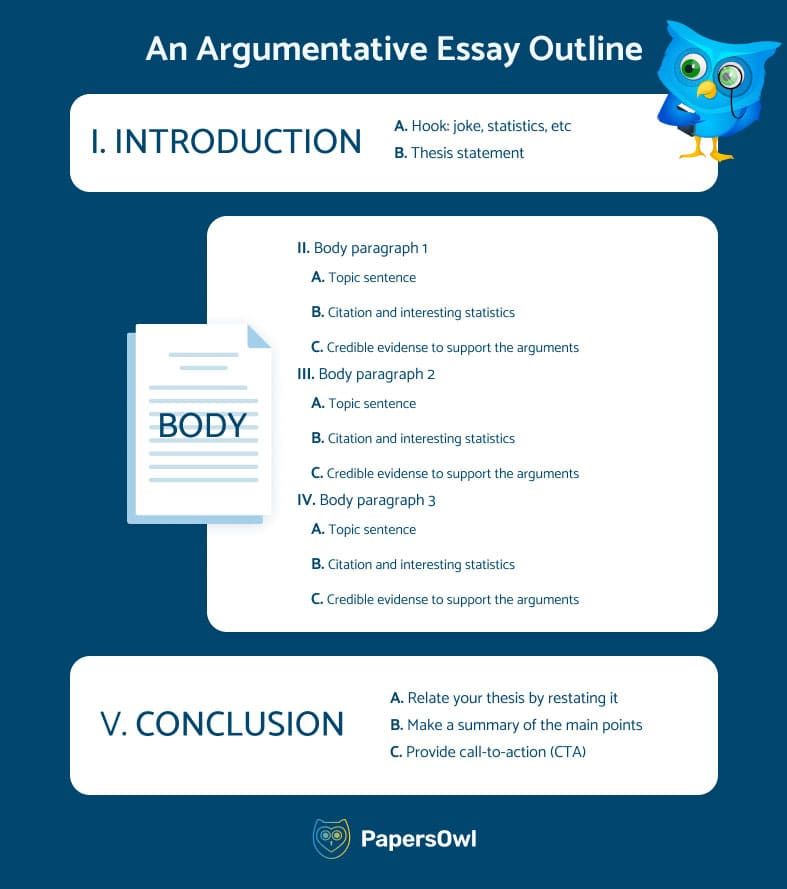
Template of Compare and Contrast Essay Outline
In a compare and contrast essay , you are exploring two or more subjects. Your outline should include sections for the introduction, points of comparison, points of contrast, and a conclusion that ties it all together. It involves writing where you should highlight in which ways certain things are similar to and different from one another. This writing assignment stimulates critical thinking and forces you to conduct a compelling analysis.
Generally, comparative essays have an introduction (topic, theme, and thesis statement), body paragraphs, and a conclusion summarising the comparison. This article will describe only some of the processes of writing a comparison essay. However, I will provide you with specific tips:
- Use cue words (also, like, similar to, unlike, compared to, nevertheless, etc.)
- Be more specific in your thesis.
By the last point, write something like “BMW and Mercedes-Benz provide the same product; however, their marketing strategy differs” instead of “This essay will compare BMW and Mercedes-Benz.”
This is what your outline should look like:
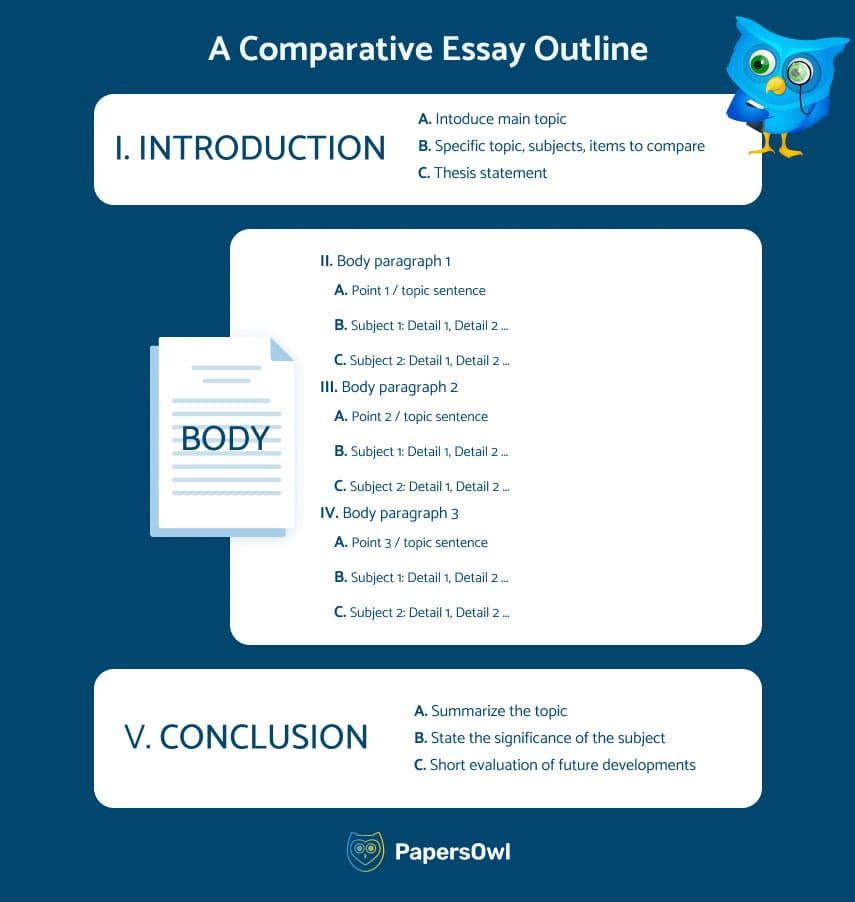
Template of Admission Essay Outline
Admission essays are your chance to stand out. Your outline should cover the introduction, your personal background, achievements, challenges faced, and why you’re a perfect fit for the institution. It’s like crafting a masterpiece self-portrait in the writing world.
These templates, such as the APA outline , offer structure and direction for different essay types, making your academic journey less daunting and more organized. So, choose the one that fits your essay type, and let it be your guiding star.
Also, before creating an essay outline, you must take some time out and search for an outline example for an essay on Google. Looking through outline essay examples can provide valuable insights into structuring your academic essays.
Benefits of the Essay Outline in the Writing Process
Imagine having a powerful tool at your disposal, one that not only simplifies your writing process but also elevates the quality of your work. An outline is that very tool, often underestimated but holding the key to success in academic and creative writing. Enhancing organization and boosting your writing efficiency brings many advantages.
Also, it acts as a lifesaver when it comes to revisions. Whether you want to rearrange paragraphs, add new points, remove irrelevant details, or need to start a planning sheet for an essay , you can do so easily without losing your way. Lastly, using an essay outline enhances the final output. It ensures your essay is well-organized, coherent, and impactful.
Therefore, a basic outline for an essay is a secret weapon in academic writing, making drafting easier, revisions quicker, and the final result more impressive.
Elevate Your Essay Writing with Outline
As we wrap up our journey through the art of essay outlining, let’s take a moment to savor the significance of this invaluable tool. Outlining an essay is not merely a roadmap but the key to unlocking your full potential. It makes essay setup a breeze, revisions a cinch, and elevates your final output. So, the next time you face a blank page, remember the trusty outline by your side, ready to guide you through the essay layout. With this ultimate guide in your toolkit, you’re well-equipped to craft essays that captivate, persuade, and inspire.
Readers also enjoyed
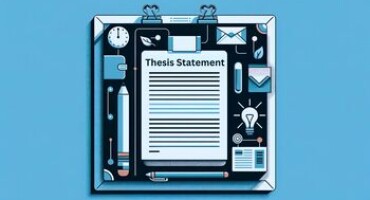
WHY WAIT? PLACE AN ORDER RIGHT NOW!
Just fill out the form, press the button, and have no worries!
We use cookies to give you the best experience possible. By continuing we’ll assume you board with our cookie policy.
How to Write an Essay Outline

Imagine that an essay outline is like building a blueprint for a house: it lays the foundation and framework for your ideas. An outline helps you organize your thoughts, ensuring that each section of your essay supports your main argument.
By mapping out your introduction, body paragraphs, and conclusion in advance, you can see the big picture and make sure all your points are connected. Let’s see why an essay outline is an important part of the writing process, as well as discover better ways to perform this task.
What Is an Outline?
An essay outline is a structured plan that organizes an essay's main ideas and supporting points before the writing process begins. It serves as a framework, breaking down the essay into key sections: the introduction, body paragraphs, and conclusion.
Each section includes brief notes or bullet points detailing what will be covered, helping to ensure a logical flow of ideas and coherence in the final piece. By providing a clear overview of the essay's structure, essay outlines make the writing process more efficient and help maintain focus on the central argument or thesis.

Lorem ipsum dolor sit amet, consectetur adipiscing elit.

Wednesday Addams
Mysterious, dark, and sarcastic
You’re the master of dark humor and love standing out with your unconventional style. Your perfect costume? A modern twist on Wednesday Addams’ gothic look. You’ll own Halloween with your unapologetically eerie vibe. 🖤🕸️
Don’t Even Have an Outline Yet?
If you feel tired and unmotivated, delegate your essay to expert writers!
Parts of an Essay to Include in the Outline
An essay structure typically includes three main parts: the introduction, body paragraphs, and conclusion. Use a coursework writing service if you’re tasked with a longer paper than a short composition.
Introduction
The introduction of an essay sets the stage for the entire piece, providing a first impression that engages the reader. It typically begins with a hook, a compelling statement or a question designed to capture the reader's interest. Following the hook, background information is provided to give context and help the reader understand the topic at hand.
This section culminates in a thesis statement, a clear and concise summary of the main argument or purpose of the essay. The introduction not only introduces the topic but also lays out the roadmap for what will be discussed, setting the tone for the rest of the essay.
Tips for the Introduction:
- Start with a strong hook to grab attention.
- Provide just enough background information to set the context.
- Craft a clear and specific thesis statement.
- Avoid overly broad or general statements.
Body Paragraphs
The essay's body is where the main ideas and arguments are developed. Each body paragraph should start with a topic sentence that clearly states the paragraph's main point. This is followed by supporting details, such as evidence, examples, and analysis, which reinforce the topic sentence.
Effective transitions between paragraphs are crucial, as they ensure the essay flows logically from one idea to the next. The body paragraphs collectively build the case for the thesis, providing depth and detail that strengthen the overall argument.
Tips for Body Paragraphs:
- Begin each paragraph with a strong topic sentence.
- Use specific evidence and examples to support your points.
- Analyze the evidence to show how it supports your argument.
- Use transition words and phrases to connect ideas smoothly.
The conclusion of an essay brings closure to the argument and reinforces the thesis. It typically begins by restating the thesis in light of the evidence presented in the body paragraphs. This is followed by a brief summary of the main points discussed in the essay, highlighting the key arguments made.
The conclusion should end with a closing thought or call to action, leaving the reader with something to ponder or a sense of resolution. The goal is to leave a lasting impression that underscores the significance of the essay’s findings.
Tips for the Conclusion:
- Restate the thesis in a new way to reflect the discussion.
- Summarize the main points succinctly.
- End with a thought-provoking final sentence or call to action.
- Avoid introducing new information or arguments.
Are you a fan of literature? Recommended for reading: The Divine Comedy summary .
How to Write an Essay Outline in 4 Simple Steps
An essay outline can simplify and enhance the writing process by organizing your ideas and ensuring a logical flow. Here’s how to write an essay outline in four steps:
.webp)
1. Identify Your Thesis and Main Points
Begin by determining the thesis of your essay—the central argument or point you intend to make. Once you have a clear thesis, identify the main points that will support this argument.
These points will form the backbone of your essay and should be distinct, relevant, and directly related to your thesis. Write down your thesis statement and list your main supporting points, which will serve as the core sections of your outline.
- Make sure your thesis is specific and debatable.
- Limit your main points to three or four to maintain focus.
- Ensure each main point clearly supports your thesis.
2. Organize Main Points into Sections
Writing an essay outline is divided into three main sections: introduction, body, and conclusion. Allocate each main point to a body paragraph, and decide the order in which you will present them.
Consider the logical progression of your argument, ensuring each point builds upon the previous one. This step helps you see the overall structure of your essay and ensures a coherent flow of ideas.
- Use a logical order, such as chronological, thematic, or order of importance.
- Ensure each section transitions smoothly to the next.
- Make sure each body paragraph addresses a single main point.
Are you pursuing an MBA degree? If yes, use our business essay writing services brough to you by certified experts.
3. Develop Supporting Details for Each Main Point
For each main point in the essay outline, jot down the supporting details you’ll use to explain and back up your argument. These can include facts, quotes, examples, and analysis.
Organize these details under each main point, creating subpoints that will form the content of each body paragraph. This step ensures that each paragraph has enough substance to support your argument and keeps your writing focused and detailed.
- Use a mix of evidence types to strengthen your argument.
- Make sure each supporting detail is relevant and directly backs up your main point.
- Balance your paragraphs: ensure they are similar in length and depth.
4. Create a Draft Outline
Combine your thesis, main points, and supporting details into a draft outline. Start with the introduction, including your hook, background information, and thesis statement. Next, outline each body paragraph, starting with a topic sentence and followed by your supporting details.
Finally, outline your conclusion, restating the thesis, summarizing the main points, and ending with a closing thought. Review your outline to ensure it’s logically structured and covers all necessary points.
- Keep your outline clear and concise.
- Use bullet points or numbering to organize your sections.
- Review and revise your outline for coherence and completeness.
Essay Outline Example
An essay outline example can help a student by providing a clear template that demonstrates how to organize their thoughts and structure their essay effectively. If you’ve got little time left until submission, click on the pay someone to write my paper link, and our specialists will sort your problem out quickly.

Persuasive Essay Outline
Literary analysis essay outline, argumentative essay outline.
An essay outline provides structure and organization, ensuring clarity and coherence in the writing process. It helps writers focus on their main arguments and prevents them from straying off-topic. Additionally, having an outline saves time by streamlining the writing process and making it easier to fill in the details.
Struggling to Wrangle Your Thoughts into a Coherent Essay?
Let us do the heavy lifting for you!
Should I Use Full Sentences in My Essay Outline?
How to create an outline for an essay, what is an outline for an essay.

is an expert in nursing and healthcare, with a strong background in history, law, and literature. Holding advanced degrees in nursing and public health, his analytical approach and comprehensive knowledge help students navigate complex topics. On EssayPro blog, Adam provides insightful articles on everything from historical analysis to the intricacies of healthcare policies. In his downtime, he enjoys historical documentaries and volunteering at local clinics.

- Updated writing tips.
- Updated examples.
- https://www.sjsu.edu/writingcenter/docs/handouts/Outline%20Template.pdf
- https://www.monash.edu/student-academic-success/excel-at-writing/how-to-write/essay/example-essay-outlines
- Structure of an Essay: Outline - Resources for Writing Different Types of Essays | Gallaudet University. (2022, November 16). Gallaudet University. https://gallaudet.edu/student-success/tutorial-center/english-center/writing/resources-for-writing-different-types-of-essays/structure-of-an-essay-outline/


Essay Outline: How To Write A Perfect Essay Outline
In this article, we are going to be talking about how to write the perfect essay outline. This is important as it gives you a good foundation on which to build you essay. We will be giving you some useful tips and ideas to ensure that you get off on the right foot.
Essay Outline

What Is An Essay Outline?
In the most simple terms an essay outline is the plan for your essay . In it, you will be able to give your essay a structure as well as detail any points which must be included in the final written piece of work. Your essay outline will give you the opportunity to note down what information is going to be presented in each paragraph , allowing you to write the essay freely and easily without having to stop to look up further information.
A good essay outline will enable the author to fully complete their essay from the notes within the outline. Some points that you might include are:
- You main point or argument on what the essay is about.
- Your thoughts and ideas which should be included.
- The structure of the essay.
- A plan of what information will be included where.
It is possible to write an essay without using an essay outline, but the end result will be nowhere near as good. In any area of life, planning can make a great difference and essay writing is no exception to this rule. The benefits of having an essay outline might be that it is an easy way to plan out and organise your ideas and will ensure that you do not miss out any key information during the writing process. Alongside this, once your essay outline is complete, writing the essay should take a lot less time.
How Should Your Essay Outline Look?
As a rule of thumb, most essays are made up from five paragraphs, although there is room for movement on this. But for the purposes of this article, we will assume that you are writing a five paragraph essay. There are usually three main parts to an essay, these are the introduction, the body (which is made up from three paragraphs) and finally the conclusion. Each of these should be plotted out within your essay outline. You might include some of the following points.
- The introduction should contain your thesis statement and this is the prime time to plan out what this should say. You will also need to refer to the subject of the essay.
- In the body of the essay you will be writing at least three paragraphs and so it is important to detail what will be discussed in each of these. You will need to plan out what statistics or data will be included in each paragraph as well as the topic, your opinions and any examples. Don’t forget to refer back to your thesis statement throughout the body.
- Finally, the conclusion will bring together all the ideas outlined in your essay. Once again, you will need to refer back to your thesis statement and be able to prove that it is correct.
Now that we know what to include within your essay outline, we are going to look at an example of what your outline might look like. You can use this as a guide to plan your own outline.
Introduction
- Introduction of the subject
- Thesis statement
Body 1st Paragraph
- Plan a sentence with an argument for your thesis statement
- Give evidence, data and facts to back up your argument.
- Refer back to your thesis and show how the information you have provided relates to it.
Body 2nd Paragraph
- Plan a second argument sentence relating to your thesis statement.
- Provide more evidence or data to back up this argument.
- Once again, refer back to your thesis statement to back it up.
Body 3rd Paragraph
- Create a final argument sentence surrounding your thesis statement
- Give evidence or data to back up your argument
- Relate this back to your thesis statement
- Provide a summary of the main argument points
- Include your thesis statement once again
- Create a call to action, this is something that you ask your reader to do once they have finished the essay.
Essay Outline Example
In most cases, an essay outline will detail ideas in order of how important they are, beginning with the most important. We are now going to look at an examples of a good essay outline to give you a better idea of how they work.
Outline For A Persuasive Essay
Why Yoga Is The Perfect Work out
Thesis statement: Yoga is the best form of exercise
Topic Sentence : Yoga is ideal for those with lower fitness levels
- Yoga can help build muscles in a slow way
- It can be done at varying levels
Topic sentence: Yoga is good for the mind
- Taking part in yoga can help you to relax
- Yoga focuses on breathing techniques which are proven to reduce stress
- Evidence to back up the previous fact.
Yoga is an excellent way of working out and can have benefits such as…
Further Tips For Creating An Essay Outline
It is important to be very clear of the process for creating your essay outline and we are now going to look at some further tips to help ensure that the process goes as smoothly as possible.
- Before you begin, you should ensure that you have thoroughly read the essay question or prompt and have understood what is being asked of you.
- You should then work out the type of essay you will need to write as well as what arguments should be included and how long the essay should be.
- It is important to remember to consider the purpose of the essay-is it to entertain, persuade or give information?
- Next it is important to think about the reader of the essay, what type of person is reading the work and what might they expect? How can you most appeal to your audience?
- It is now time to come up with your thesis statement. This should be something which grabs the attention of the reader and gets them emotionally involved right from the start.
- Decide on whether you will use an alphanumeric format or a decimal format-usually an essay outline uses an alphanumeric structure but either is fine depending on which one you feel works best for you.
- You are now ready to follow the steps we have detailed on creating your essay outline.
How to Write a Quick Essay Outline | Video
- Latest Posts
- 10 Rare Words for Expanding Your English Vocabulary - June 5, 2024
- What Does the Term “Hypocritical” Mean? - January 27, 2024
- SWAG Meaning: What Does it Mean? - January 25, 2024
Improve your writing with the help of AI writing assistants!

- PRO Courses Guides New Tech Help Pro Expert Videos About wikiHow Pro Upgrade Sign In
- EDIT Edit this Article
- EXPLORE Tech Help Pro About Us Random Article Quizzes Request a New Article Community Dashboard This Or That Game Forums Popular Categories Arts and Entertainment Artwork Books Movies Computers and Electronics Computers Phone Skills Technology Hacks Health Men's Health Mental Health Women's Health Relationships Dating Love Relationship Issues Hobbies and Crafts Crafts Drawing Games Education & Communication Communication Skills Personal Development Studying Personal Care and Style Fashion Hair Care Personal Hygiene Youth Personal Care School Stuff Dating All Categories Arts and Entertainment Finance and Business Home and Garden Relationship Quizzes Cars & Other Vehicles Food and Entertaining Personal Care and Style Sports and Fitness Computers and Electronics Health Pets and Animals Travel Education & Communication Hobbies and Crafts Philosophy and Religion Work World Family Life Holidays and Traditions Relationships Youth
- Browse Articles
- Learn Something New
- Quizzes Hot
- Happiness Hub
- This Or That Game
- Train Your Brain
- Explore More
- Support wikiHow
- About wikiHow
- Log in / Sign up
- Education and Communications
- Writing Techniques
- Planning Your Writing
How to Write an Outline
Last Updated: September 29, 2024 Fact Checked
Planning Your Outline
Structuring your outline, organizing your ideas, finalizing your outline, sample outlines, expert q&a.
This article was co-authored by Emily Listmann, MA and by wikiHow staff writer, Danielle Blinka, MA, MPA . Emily Listmann is a Private Tutor and Life Coach in Santa Cruz, California. In 2018, she founded Mindful & Well, a natural healing and wellness coaching service. She has worked as a Social Studies Teacher, Curriculum Coordinator, and an SAT Prep Teacher. She received her MA in Education from the Stanford Graduate School of Education in 2014. Emily also received her Wellness Coach Certificate from Cornell University and completed the Mindfulness Training by Mindful Schools. There are 18 references cited in this article, which can be found at the bottom of the page. This article has been fact-checked, ensuring the accuracy of any cited facts and confirming the authority of its sources. This article has been viewed 3,971,049 times.
An outline is a great way to organize ideas and information for a speech, an essay, a novel, or a study guide based on your class notes. At first, writing an outline might seem complicated, but learning how to do it will give you an essential organizational skill! Start by planning your outline and choosing a structure for it. Then, you can organize your ideas into an easy to understand outline.
How to Create an Outline
- Choose your topic and thesis.
- Pick a format for your outline (e.g., alphanumerical vs. decimal).
- Cluster any similar ideas together.
- Start your outline with an introduction heading and follow with body headings.
- Include 2 subpoints for every main idea, and 2 supporting details for each subpoint.
- Add extra details and layers if you need them.
- Outline your conclusion.
Quick Outline Slideshow

- Some people process their ideas better when they write them down. Additionally, you can easily draw diagrams or examples, which might help you conceptualize the subject. However, it might take longer to write out your outline, and it won't be as neat.
- Typing your outline might be easier if your notes are already typed on the computer, as you can just copy and paste them into your outline. Copying and pasting also allows you to easily rearrange your sections, if necessary. Also, it will be easier to copy and paste information from your outline into your paper if you type your outline. On the other hand, it's harder to jot down notes in the margins or draw out organizational diagrams.

- If you’re working on a creative project, such as a novel, identify your concept, genre, or premise. Then, allow the outlining process to help you structure your work.
- It’s okay if your topic is somewhat broad when you first start, but you should have a direction. For example, your history paper topic could be French life during the German occupation of France in World War II. As you write your outline, you might narrow this down to the resistance fighters called maquisards .

- For a school assignment, review the assignment sheet or talk to your instructor. If the outline is for work, use an existing outline as a model for yours.
- If you are the only person who will see the outline, you can choose formatting that works for you. For example, you might write your outline in shorthand.

- Paraphrased ideas
- Historical facts

- Freewrite as ideas come to you.
- Create a mind map .
- Write your thoughts on index cards.

- For example, you may be writing a paper about policy change. Your thesis might read, “Policy makers should take an incremental approach when making policy changes to reduce conflict, allow adjustments, and foster compromise.” Each of the 3 reasons listed in your thesis will become its own main point in your outline.

- Roman Numerals - I, II, III, IV, V
- Capitalized Letters - A, B, C
- Arabic Numerals - 1, 2, 3
- Lowercase Letters - a, b, c
- Arabic Numerals in Parentheses - (1), (2), (3)

- 1.1.1 - Each side presents a case before the vote
- 1.1.2 - Citizens voice their opinion
- 1.2 - Neither side gets everything they want

- You might use short phrases to quickly organize your ideas, to outline a speech, or to create an outline that’s just for you.
- You might use full sentences to make it easier to write a final paper, to make a good study guide, or to fulfill the requirements of an assignment.

- If you jotted down your ideas or made a mind map, use different colored highlighters to identify ideas that belong in the same group.
- Sort your index cards, if you used them to brainstorm. Put cards with related ideas together. For example, you can put them in stacks, or you can line your cards out in rows to make them easier to read.

- For example, your main point might be that Mary Shelley’s Frankenstein champions emotion over reason. Your subpoints might be that Victor Frankenstein is restored by nature and that his scientific efforts create a monster. As supporting details, you might include quotes from the book.
- If you're writing a story or presenting a historical argument, a chronological order makes sense. For an essay or speech, pick the subtopic with the most supporting materials, and lead with this argument. From there, order your major subtopics so each one naturally flows into the next. [14] X Research source
- Your broad ideas should connect back to your thesis or controlling idea. If they don’t, rewrite your thesis to reflect the main ideas you’re putting into your outline.

- Hook to grab the audience
- 1-2 general statements about your topic

- Phrase outline: II. Frankenstein champions emotion over reason
- Full sentence outline: II. In Frankenstein , Mary Shelley champions the use of emotion over reason.

- Depending on the purpose of your outline, you might have more subpoints. For example, a novel may have many subpoints. Similarly, a study guide will likely have several subpoints, as well.

- In an essay, this is often where you “prove” your argument.
- For a creative work, you might include essential details you must include in that scene, such as an internal conflict in your main character.
- Similar to subpoints, you may have more supporting details, depending on your purpose. A novel or study guide will likely have more supporting details.

- Roman Numeral
- Capital Letter
- Arabic Numeral
- Lowercase Letter
- Arabic Numeral in Parentheses

- Restate your thesis.
- 1-2 summarizing sentences.
- Write a concluding statement.

- This also gives you a chance to look for missing parts or ideas that aren’t fully fleshed. If you see areas that leave questions unanswered, it’s best to fill in those gaps in information.

- If you are making an outline for yourself, you might not worry about this.

- It’s a good idea to have someone else check it for errors, as it’s often hard to recognize errors in your own work.
- While you edit your outline, refer back to your assignment sheet or rubric to make sure you've completely fulfilled the assignment. If not, go back and correct the areas that are lacking.

- You can use more layers if you want to include more information.
- You might also include additional layers for a long creative work or a detailed study guide.

- Be concise and straightforward in your outline. This doesn't have to be perfectly polished writing; it just has to get your point across. Thanks Helpful 0 Not Helpful 0
- Don't be afraid to eliminate irrelevant information as you conduct more research about your topic and narrow your focus. Thanks Helpful 0 Not Helpful 0
- You can use outlines as a memorization tool . Choose concise words to trigger a concept. Thanks Helpful 0 Not Helpful 0
Tips from our Readers
- Only add the most important details to your outline; otherwise, your paper may be too long.

- Generally, you should avoid only having one point or sub-point on any outline level. If there is an A, either come up with a B or fold A's idea into the next level up. Thanks Helpful 4 Not Helpful 2
- Your outline should not be your essay in a different form. Only write down the major assertions, not every single detail. Thanks Helpful 2 Not Helpful 1
You Might Also Like

- ↑ https://guts.wisc.edu/2020/11/19/pros-and-cons-of-typed-digitally-handwritten-and-paper-notes/
- ↑ https://www.iup.edu/writingcenter/writing-resources/organization-and-structure/creating-an-outline.html
- ↑ https://academicguides.waldenu.edu/writingcenter/writingprocess/outlining
- ↑ https://www.ndsu.edu/pubweb/~cinichol/271/OutlinesHowTo.htm
- ↑ https://libguides.usc.edu/writingguide/abstract
- ↑ https://www.unr.edu/writing-speaking-center/writing-speaking-resources/outline-creation
- ↑ https://u.osu.edu/hackingthethesis/managing-stuff/your-content/outline/
- ↑ https://owl.purdue.edu/owl/general_writing/the_writing_process/developing_an_outline/types_of_outlines.html
- ↑ https://libguides.pvcc.edu/outline
- ↑ https://writing.ku.edu/prewriting-strategies
- ↑ https://libguides.usc.edu/writingguide/outline
- ↑ https://www.grammarly.com/blog/how-to-write-an-introduction/
- ↑ https://www.hunter.cuny.edu/rwc/handouts/the-writing-process-1/organization/Guidelines-For-Outlining
- ↑ https://kirkwood.pressbooks.pub/emcworthy/chapter/outlining/
- ↑ https://courses.lumenlearning.com/suny-realworldcomm/chapter/9-4-outlining/
- ↑ https://owl.purdue.edu/owl/general_writing/common_writing_assignments/argument_papers/conclusions.html
- ↑ https://academicguides.waldenu.edu/writingcenter/writingprocess/revising
About This Article

The easiest way to write an outline is to gather all of your supporting materials, like quotes, statistics, or ideas, before getting started. Next, go over your materials and take notes, grouping similar ideas together. Then, organize your ideas into subtopics and use your materials to provide at least two supporting points per subtopic. Be sure to keep your outline concise and clear, since you’ll have to refer to it later! For more help on how to plan and organize your outline, read on! Did this summary help you? Yes No
- Send fan mail to authors
Reader Success Stories
Apr 22, 2018
Did this article help you?
Kember Miller
Jan 14, 2018
Oct 25, 2017
Sep 26, 2016
Apr 26, 2022

Featured Articles

Trending Articles

Watch Articles

- Terms of Use
- Privacy Policy
- Do Not Sell or Share My Info
- Not Selling Info
Don’t miss out! Sign up for
wikiHow’s newsletter
How To Write An Essay Outline: Tips And Examples
- What Is An Outline?
- Why Are Outlines Helpful?
- Parts Of An Outline
To outline or not to outline: that is the age-old question. For a lot of people, outlines are a way to organize thoughts and gather information before they start writing, which can often save valuable time later on. But some writers prefer to craft essays more loosely, adding material and shaping their supporting paragraphs as they go.
Whether you’re new to outlines (or writing, period) or you’re just looking to hone your skills at crafting the perfect essay outline, there are some important things to know about the process. Follow along as we break down the why and the how of writing an effective outline and provide a step-by-step guide that will make writing your next essay a total cinch.
What is an outline?
An outline is “a general sketch, account, or report, indicating only the main features, as of a book, subject, or project.” In other words, it’s like a brief summary of the topics you plan to cover in a longer piece of writing.
In writing an outline, you create the skeleton of your essay, which provides a supportive structure on which you can arrange and organize each of your paragraphs. This helps you clarify the points you intend to make in your writing and also gives you an opportunity to tailor your research, which can make the writing process much easier later on.
Why are outlines helpful?
If you aren’t typically an outline writer, you might be wondering if you really need to put in the extra work to create one. Ultimately, everyone has a different writing style, and only you know what’s going to work for you, but here are four major reasons why many people find the outlining process helpful:
1. Outlines are brief and concise.
Remember: an outline is not the same thing as a rough draft. In an outline, each section contains only a sentence or two, and each topic is distilled to a single main idea.
2. Outlines help you write more efficiently.
You don’t have to worry about rambling or repeating the same statistic several times. You decide exactly where information belongs before you start writing.
3. Outlines are easy to edit.
You can move facts, details, and even entire sentences around easily without needing to rewrite whole paragraphs.
4. Outlines ensure supporting details connect to the thesis.
Once you see all of your work laid out, you might realize that certain paragraphs can be combined or that your conclusion doesn’t actually tie back to your thesis. Isn’t it nice to notice these potential errors before you’ve finished a draft?
Writer’s block? It’s part of the process. Here are some tips to overcome it and get your words flowing again.
The parts of a standard essay outline
Now that you understand the “why” behind writing an essay outline, let’s talk about how to do it. Here are the main parts to include in any essay outline:
Introduction
In an outline, your introduction consists of your thesis statement . This is a single sentence that states the subject, main idea, or main purpose of your essay.
When you write your essay, you will add a few sentences before and after your thesis statement to grab your reader’s interest and preview your essay’s main points. For the outline, you only need to narrow your point of view to a single, effective thesis that will inform the rest of the outline.
Body paragraphs
Body paragraphs are the parts of the essay in which you present information to back up your thesis. First, you’ll need to decide if you’re writing a three-paragraph essay or a five-paragraph essay . You may have anywhere from one to three body paragraphs, depending on what type you choose.
Each body paragraph in your outline should have:
- A main idea that aligns with your thesis.
- A topic sentence stating the main idea.
- A bulleted list of relevant research, quotes, anecdotes, and/or statistics.
Much like the introduction, your outline’s conclusion is all about your thesis statement. Here, you should:
- Restate your thesis
- Summarize the main points that support your thesis.
- Leave your reader with an impactful final thought or call to action.
Make Your Writing Shine!
- By clicking "Sign Up", you are accepting Dictionary.com Terms & Conditions and Privacy policies.
- Email This field is for validation purposes and should be left unchanged.
Example of a standard essay outline
Now that you know the parts of an essay outline, it might help to see them in action. Here’s an outline format you can use to plan your own essays, filled in with examples of a thesis statement, topic sentences for your body paragraphs, and the main parts of a strong conclusion.
- Thesis statement: There’s a lot of debate about which food category hot dogs fit into, but it’s clear from the evidence that a hot dog is a type of sandwich.
Body paragraph #1
- Topic sentence: To begin, hot dogs fit the dictionary definition of the word sandwich.
- Supporting detail: Sandwich is defined as “two or more slices of bread with a layer of meat, fish, cheese, and whatever other filling you’d like between them.”
- Supporting detail: A hot dog is a grilled or steamed sausage, usually made of pork or beef, which qualifies as a layer of meat.
- Supporting detail: Hot dog buns are split rolls, similar to the ones used for deli sandwiches.
Body paragraph #2
- Topic sentence: Secondly, hot dogs meet the legal definition of sandwiches in many places.
- Supporting detail: Mark Wheeler, a food safety specialist with the US Department of Agriculture (USDA), says the organization defines a sandwich as “a meat or poultry filling between two slices of bread, a bun, or a biscuit.”
- Supporting detail: In New York state, tax law lists “hot dogs and sausages on buns” as types of sandwiches.
- Supporting detail: Additionally, tax law in California clearly includes “hot dog and hamburger sandwiches” served from “sandwich stands or booths.”
Body paragraph #3
- Topic sentence: Finally, most Americans agree that hot dogs are sandwiches.
- Supporting detail: In a poll of 1,000 people conducted by RTA Outdoor Living, 56.8% of respondents agreed a hot dog is a sandwich.
- Supporting detail: Many fast food chains that serve primarily burgers and sandwiches, like Five Guys burgers and Shake Shack, also sell hot dogs.
- Supporting detail: Lexicographers at Dictionary.com have also declared that hot dogs officially meet the criteria to be included in the sandwich category. (Curious? Read the article here for this and other great food debates explained .)
- Restatement of thesis: Hot dogs are a unique kind of food, but the evidence makes it clear that they are indeed a type of sandwich.
Now, get to planning that perfect essay! (But if you’re hungry for a snack first, we don’t blame you.)
Plan and write a five-paragraph essay that will earn your instructor's own five—high five, that is!

Ways To Say
Synonym of the day

Get Free Profile Evaluation

How to Write an Essay Outline: Templates and Examples

Looking for an outline for an essay to help you with an upcoming assignment? Don’t worry; we’ll give you everything you need to know about essay outlines!

Students take all kinds of classes throughout their academic careers. They learn about the basic principles of the world in science, how we got to where we are today in history, and how to dissect an Elizabethan-timed soliloquy reading Shakespeare in English.
While subjects differ drastically in the topics they teach, you can bet that they all rely on students interpreting material to analyze and reach a conclusion with. Non-quantitative subjects, like psychology, history, and English, often require students to format their arguments in various essays.
But how do you go about starting an essay? Well, a key area that students often neglect is looking into outline examples for essays. Having a scaffold to support your arguments and research means you’ll be able to focus on writing without getting distracted. Ideally, you’ll experience an extended writing flow state without any writer’s block.
If streamlining the writing process and making things easier for yourself sounds appealing, then keep reading for the outline tips you need!
What Is an Essay Outline?
An essay outline is a brief snapshot into the structure of your essay. It’s often informal and mostly written without an intended audience other than the essay author. An outline will state the main points that are being established throughout your essay and how they’re being supported.
Essays rely on internal logic to be effective. Think of essay outlines as a method of laying out the flow of your essay, especially making note of how the arguments reinforce one another. A good outline will provide effective points that tie back to your thesis.
You may also be requested by your teacher to make an outline so they can provide feedback. This is a good way to get advice when you’re starting out writing essays or writing about more complicated topics. That way, you’ll be able to start writing good essays in no time.
Typical Parts of an Essay
Although essay structure does vary depending on the kind of essay , there are a few universals across the writing format. Virtually all essays begin with an introduction and end with a conclusion. The body paragraphs that support the central theme vary in length, quantity, and structure.
Ideally, the introductory paragraph should give the reader a cursory overview of the arguments that support your thesis, which is the central theme unifying the text. A line to hook your audience can also make for a more compelling essay.
In the conclusion, you’ll want to briefly summarize the points you made throughout the body paragraphs. Furthermore, any closing thoughts you have or final ideas you’d like to leave the reader with can be discussed here.
Steps for Writing an Essay Outline
Writing an essay template doesn’t need to be difficult or time-consuming. With the right steps and planning, you can not only save yourself a great deal of time but also write more persuasive content. The ins and outs of writing an essay outline follow multiple steps. Here are some things to think about:
Step One: Develop a Thesis
The first and most important step before beginning your essay outline is to try to determine a thesis that captures the core of what you’re arguing. Without a thesis, any arguments made in the body paragraphs don’t have a central theme to support. In this case, it can be easy to get off topic or even inadvertently argue against your thesis.
Step Two: Prioritize Research
You’ve no doubt come across a ton of ideas and thought of different arguments to make during your time planning for your essay (or checking out what SparkNotes had to say if it’s last minute). Regardless, a decision has to be made as to what the strongest arguments that support your thesis are.
An extra tip: don’t discard points that go against your thesis! These can be collected and used to dispel counter arguments in your essay. Articulating persuasive viewpoints means tackling objections head-on and giving a more compelling argument. Also, make sure you’re understanding everything you’re reading before writing about it.
Step Three: Structure Body Paragraphs
The exact structure and contents of the body paragraphs within an essay can change depending on the essay format. Generally, each body paragraph should focus on a supporting argument that defends your thesis. In a sense, each body paragraph comprises a mini-thesis that aligns with the overall goals of the essay as a whole.
One approach is to give one or two pieces of evidence that reinforce the body paragraph’s argument. These could come from research you had done on your topic beforehand or from a primary source that’s being discussed. Alternatively, you could include any counter arguments that directly go against the body paragraph’s stance.
Another common pitfall students make is including body paragraphs that are too similar to one another. In order to give the most compelling arguments, you should ideally be tackling your subject matter from all angles. Including a variety of opinions ensures that your essay encompasses many diverging views, making your thesis more compelling.

Essay Outline Examples
A standard essay can be written in a five-paragraph structure. Certain essays, such as expository essays , work well with this outline. In this case, you’d want to include an introductory paragraph that clearly states your thesis. This is followed by three supporting body paragraphs. Finally, a conclusion is used to wrap everything up.
As with the steps for writing an essay outline, you’ll always want to include an introduction and conclusion, no matter what kind of essay you’re writing. To determine the structure of the body paragraphs, consider looking at what research you’ve done on the topic and what would make the most sense for the essay you’re writing.
Essay Outline Template
A rough outline template for an essay can include all the features from your outline. When dealing with five-paragraph essays, you can format a rough template with a few basic categories. A common template taught in college-level English looks something like this
- Introduction paragraph
- Body paragraph one
- Body paragraph two
- Body paragraph three
- Conclusion paragraph
Although this isn’t the only way to structure an essay, having some kind of template will make the writing process as easy as possible. When you have to interrupt your writing with research, you’ll find it makes it harder to write concisely, establish points, and transition between them.
Still have questions concerning essay outlines and templates? Check out our expert answers below for more insight!
1. How Can I Think of What to Write for My Essay?
A big sticking point for students is getting started with their essays. More often than not, students envision the writing process as a seamless block of time where academically studious peers complete their essays in a single session. This could not be further from the truth.
Writing is a responsive process more than anything. This means that without adequate research, you’ll find it increasingly difficult to have topics to write about or think of. That’s not to say essay writing is completely linear. You’ll likely need to go back and consult your research to revise arguments. However, a gradual progression is usually followed.
Don’t forget a non-linear process can actually help you generate ideas for your essay. Certain essay-writing tips , such as expanding on your thesis and using temporary subheadings, can help generate crucial concepts to communicate your arguments.
2. What’s the Point of Writing Essays?
Although it may seem like pointless homework, writing essays develops fundamental skills that enable you to function and excel in society. Sure, you may be wondering how writing about the whaling in Moby Dick is going to come in handy in life ten years from now. The real key is the linguistic and logical neural pathways being developed.
Essay writing is quite different from prose writing. There is a certain structure where sound logic matters. You can’t simply come up with a thesis and talk about irrelevant points that do no help defending it. The logic required to draw conclusions from research and literary works is a skill that needs to be practiced.
Being able to defend arguments in widely different settings requires critical thinking. Not everyone can come up with an essay on the spot. It takes time to develop the thinking process behind the writing in order to make logically consistent arguments. Fortunately, anyone can develop their talents with the right practice and determination to get better.
Final Thoughts
Writing essays is an involved process. If you’re just starting out and haven’t perfected your writing regimen, then doing a bit of planning can make all the difference in your final draft. Whenever you’re feeling overwhelmed or experiencing writer’s block, it can be a good idea to go back and consult your outline for your essay.
There may be several different kinds of topics to write about. Almost all non-quantitative classes have written components, and essays make up a large bulk of that. What all effective essay writing has in common is clearly articulated thoughts, with the reader easily understanding what message is being conveyed.
No one starts out writing perfect essays with ease, but the more often you write, the better you’ll get at the process. The most important thing to take away from essay writing is to give yourself a bit of review, especially a few months later. Give it a read with fresh eyes and see how you can improve for next time.
Book Your Free Assessment Today

- Admissions Essays
- Books and Manuscripts
- Business Proofreading and Editing
- Dissertations
- Editing Tools
- Personal Statements
- Professional Writing
- Proofreading and Editing
- Thesis Proposals
- Uncategorized
- Working From Home
- Writing Fiction
- Writing Guides
How to Outline an Essay

Get 400 words proofread and edited for free
The single biggest time waster in writing is staring at the blank page.

The “inverted triangle” and free writing will get words on the page, but they’re probably going to be junk you will either delete later or turn in for a D+. An essay isn’t just a bunch of words.
The only real solution is to recognize that you’re approaching that blank page the wrong way. Trying to figure out everything at once and shove it all into a sentence is impossible, like trying to eat a sandwich you haven’t actually made yet.
Get a free sample proofread and edit for your document. Two professional proofreaders will proofread and edit your document.
That’s where the outline comes in. You focus on the first task first and all by itself: what to say. Don’t worry about the words yet. Don’t even think about complete sentences. This is only about lining up your content.
The best part? Writing an outline uses a template, which means never starting with a blank page ever again.
Here’s your basic template for a four-paragraph essay:
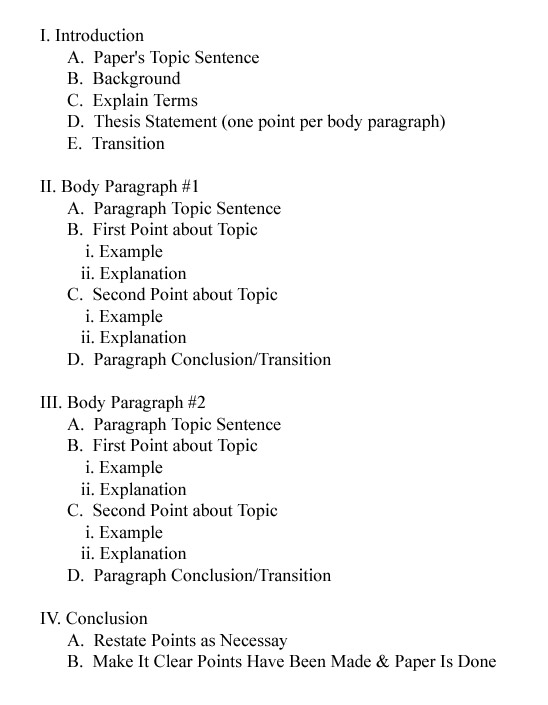
That’s an intro (which you will write last), two paragraphs for the body of the paper, and a conclusion. Skip even outlining the intro for now. Look at the body. That’s where the paper really lives and works.
So, looking at the template, we know we need to have two basic ideas for this paper, one for II-A and one for III-A.
Two ideas. That’s what we’re concentrating on before anything else. (And remember that it’s the content of your essay that determines the grade, not the loveliness of your prose.)
If you’ve got your two ideas ready to go, great. If you haven’t got your two ideas ready, then it’s time to do the research or talk about it with your instructor or your friends or your houseplant until you have figured out your two ideas.
And remember, these need to be ideas, not topics. “Fruit” is not an idea. Neither is, “I like bananas.” An idea about bananas would be, “Bananas are usually considered sweet, but they work well in succulent dishes too.” (In the outline, this could read: “bananas sweet/good for meat/chicken cooking.”)
Plug your ideas into the template. Look at them. Are they in the right order, or should you switch them around?
Now look at the paragraph template for each idea. Start coming up with your examples and explanations for those ideas (no sentences, just the words that tell you what you want to say). Figure out what ground you need to cover to make your ideas complete.
You will find the template of your outline will encourage you to stay focused on your ideas and on what you need to say about those ideas, but don’t forget that the template is adaptable. If one of your ideas gets too big for one paragraph, stick another body paragraph template in there. Add in more examples and explanation as needed as well.
Once you’ve reached the stage where your body paragraphs are mapped out, you now have your thesis statement. Plug the list of your ideas in order in I-D. Look at that list of ideas. What will the instructor need to know to understand what those ideas mean? Jot down that information in I-B and I-C.
Now drop down to the conclusion. Is your essay long and/or complicated enough that you need to repeat your ideas? If not, skip IV-A. Think about what you might say for IV-B. For a basic essay, a one-sentence conclusion is often just fine.
Now go all the way back up to I-A. Your topic sentence should be as narrow as possible while covering the entire essay. What key words do you want to use? Plug them in. Your thesis statement is simply a summary of the points in your body paragraphs stated in the same order.
And now, look! You have an outline that lists everything you want to say in the order in which you want to say it. Blank page, take that!
Look over your outline. Which body paragraph do you want to write first? Use the outline to guide you sentence by sentence.
Once you have the body written, then you write the conclusion and, finally, the intro. Now that first sentence of the paper is easy because you know what you want to say—in fact, you’ve already said it.

Get a Free Sample
We will get your free sample back in three to six hours!
We proofread documents 24/7 Support 888-833-8385

Customer Service
Get in touch.
ProofreadingPal LLC 105 Iowa Ave., Ste. 214 Iowa City, IA 52240
Call Us 888-833-8385
Live Customer Support Hours Sun.-Thurs. 8 a.m. to midnight CT and Fri.-Sat. 8 a.m. to 6 p.m. CT
Submit Documents 24/7
© 2010 - 2020 ProofreadingPal LLC - All Rights Reserved.
We Use Cookies
We use cookies to improve your experience on this website.
Cookies Settings
Necessary cookies help make a website usable by enabling basic functions like page navigation and access to secure areas of the website. The website cannot function properly without these cookies
Statistic cookies help website owners to understand how visitors interact with websites by collecting and reporting information anonymously.
Marketing cookies are used to track visitors across websites. The intention is to display ads that are relevant and engaging for the individual user and thereby more valuable for publishers and third party advertisers.
The Vocative Comma Is Important, People! · September 25, 2022
8 Tips to Make Your Writing Sound More Formal · August 29, 2022
Worlde Tips and Tricks · March 10, 2022
Worlde Tips and Tricks · February 25, 2022
Top 4 Misspelled Words · November 5, 2021
How to Capitalize Medicine · October 1, 2021
How to Capitalize Medicine · August 18, 2021
4 Fixes for Comment Boxes in MS Word · January 17, 2021
How to Avoid Wordiness · July 15, 2020
Write an Effective Blog Post · June 9, 2020
Proofreading Services Rates · April 19, 2020
How to Make Your Writing More Inclusive · March 5, 2020
How to Make Your Writing More Inclusive · February 27, 2020
Guide to Olde English · December 27, 2019
Guide to Olde English · December 26, 2019
Common Apostrophe Errors · December 19, 2019
Guide to Olde English · December 18, 2019
Capitalization in APA, Chicago, MLA, and AP · August 27, 2019
Avoiding Common Capitalization Errors · July 31, 2019
- Essay Guides
- Basics of Essay Writing
- Essay Outline: How to Write It & Templates for Different Types
- Speech Topics
- Essay Topics
- Other Essays
- Main Academic Essays
- Research Paper Topics
- Basics of Research Paper Writing
- Miscellaneous
- Chicago/ Turabian
- Data & Statistics
- Methodology
- Admission Writing Tips
- Admission Advice
- Other Guides
- Student Life
- Studying Tips
- Understanding Plagiarism
- Academic Writing Tips
- Basics of Dissertation & Thesis Writing
- Research Paper Guides
- Formatting Guides
- Basics of Research Process
- Admission Guides
- Dissertation & Thesis Guides
Essay Outline: How to Write It & Templates for Different Types

Table of contents
Use our free Readability checker
An essay outline is a plan that helps you organize your thoughts and ideas before you begin writing your essay. A well-constructed outline can help you ensure that your essay is structured logically and includes all of the necessary information.
Today, we will learn everything about essay outlines. Academic writing is challenging enough. So we would really want to ease the overall process and ensure that you’re prepared to write the best essay possible. Are you confused about how to structure your paper? Do you not understand the difference between different types of articles? The answers to all of those questions and even more points will be covered here. So stick around and get all the information you can possibly need!
What Is an Outline for an Essay?
What is an essay outline? It is a good question, and we are excited to answer it. In simple terms, it is how your essay will be structured and what things it might feature. You can include the following items in your structure:
- Your general topic
- Thesis statement
- A number of paragraphs
- Topic and concluding sentences for each paragraph
- Resources or evidence used in your body paragraphs.
Trust us, following this list and ideas will save you a lot of time and help you in crafting a very good article.
Why Do You Need an Outline of an Essay?
Outline for an essay is crucial for several reasons. So here’s a quick list of why you’re writing and why research requires a good essay structure example . It helps you:
- Develop a logical and well-thought-out piece.
- Convince your readers that you’re making a valid point.
- Save some time.
- Don’t get lost in all the evidence and ideas you have for your paper.
- Consider purchasing a college essay for sale in case this is too difficult.
Basic Outline for an Essay: Template
For starters, we wanted to give you an essay outline template. It is an effective way to make sure you have all the required points of a good article. By keeping everything organized, you will get our highest mark and develop a believable argument . But, of course, here is the template and enumeration of all the sections you need:
- First piece of evidence
- Second piece of evidence
- Summary or so-called synthesis
- Importance of topic
- Strong closing statement
How to Write an Essay Outline
How to write an outline for an essay? That's a $1 million question that we will answer today. You should understand from the very beginning that writing or mapping out your structure will take some time. But don't let this fact discourage you because it will be worth it in the end. However, we have also prepared several tips for you in order to ease the process even more:
- Research a topic before you actually start writing.
- Consider a type of article you're writing and pick an appropriate structure.
- Start outlining from the very beginning.
- Write down your thesis and make sure it is bulletproof.
- Provide some evidence you will use to support your argument.
Essay Outline Template
Our outline for the essay template will differ depending on the type of essay you will be writing. Interestingly enough, there are many types of academic essays you can consider. You can write an argumentative, persuasive one or a common narrative, or even an expository essay. As a result, choosing a relevant outline and structure will help you to distinguish our mentioned types and nail the one you’ve picked. Professional essay writers at StudyCrumb might help you with that.
Persuasive Essay Outline
We will start with how to write a persuasive essay outline and the similar one is an argumentative essay outline . You can find the structure itself down below. But we wanted to remind you of several things. Students often forget to cite their sources. So it is rather a good idea to include not only the evidence but citations and sources when outlining.
- Catchy hook to engage your reader
- Background information on your topic
- Thesis statement (mention all points that will be discussed in body paragraphs)
- Paragraph 1 with supporting evidence proving your point (+Topic Sentence)
- Paragraph 2 with evidence proving your point (+Topic Sentence)
- Paragraph 3 with evidence proving your point (+Topic Sentence)
- Rephrase a thesis statement
- Conclude all points leaving a final impression
Narrative Essay Outline
We also know how to write a narrative essay outline . This type of article tries to tell a story, and that is why it is called narrative. Our best stories will have a rising action, climax, and a falling action. But to time everything perfectly and make sure your readers are at the address of the receipt, outlining is your best friend. Besides, not to forget the information you wanted to include, our structure below will help you write a very good narrative article.
- Scene setting
- Mentioning your purpose of writing
- Rising action
- Climax (some epic event)
- Falling action (conflict resolution)
- Moral of your story or possible lessons
Expository Essay Outline
An expository essay outline is very close to our previous options. It includes the same points. So you also start with an introduction, follow with three body paragraphs and finalize everything with a conclusion. Trust us: the process of writing will be much easier with such structure. Hence, our key for a good essay is right here:
- Topic background
- Topic sentence
- Supporting explanation
- Supporting example that backs up your topic sentence and explanation
- Summarizing or concluding statement
- Rephrase your thesis
- Summarize and connect your key points
- Leave a final impression with recommendations
Informative Essay Outline
Outline for an informative essay follows an already well-known structure. Don’t forget that your body paragraphs should have lots of details and relevant information. Each claim must be supported. Therefore, every article has a specific order that cannot be broken. If you don’t follow the structure, your argument may not be as strong as the ones following the given order.
- Topic background (general information)
- Supporting pieces of evidence
- Transition and concluding statement
- Leave a final impression with recommendations or future developments
Compare and Contrast Essay Outline
Compare and contrast essay outline will definitely be useful. A lot of colleges and schools like this type of essay because this is a good practice of analytical skills. It is natural because you have a lot of information and evidence. Besides, you're comparing different items, and tracking them might be a challenge for everyone. Out of all essays, this one, above all, needs a good structure. So make sure you understand the difference between your subjects, include evidence, and focus on your thesis statement:
- Topic sentence 1
- Subject 1: Detail 1
- Subject 2: Detail 1
Rhetorical Analysis Essay Outline
Your rhetorical analysis essay outline is our last one, so we hope you’re happy. Just like you always do, include evidence to support your argument and do research before the actual writing. In our rhetorical analysis, you have to highlight the strategies and approaches the author used in their text. Therefore, the good idea is to use quotations from the text.
- General information
- Used rhetorical strategies
- How well the strategy works in this example? Provide quotes from the text
- Reasons behind picking these approaches and not any other
Outline Example for Essay
So far, we have told you about the stages you should follow to make up a plan for your future essay. It is more convenient to have an outline essay example in front. This will help to create an effective plan and then compile a really good writing piece based on it. The main thing is to include as much information as possible into your plan; our outline template for essay will help you with this task. Don't forget to buy essay now if you're still not sure whether you'll be doing this task.

Final Thoughts on Writing an Essay Outline
Awesome job because now you know how to quickly write an essay outline. A quick reminder before we wrap this up. You create an outline or write down the structure to keep track of all the information. Don’t forget that different types of academic papers and articles require their respective structures. So save this guide in order not to lose them.
You can always rely on our essay writing service. Backed by unrivalled experience, our writer will be happy to provide you with the fantastic result in a timely manner.
FAQ About Outline for Essay
1. what is the topic outline.
An essay topic outline is a process of arranging your ideas. This structure can show you the higher key or gradation of your main points. Therefore, you have your main point or argument and several sub-points. It is up to you to arrange them in order of importance and highlight the most crucial ones.
2. How long is an outline for an essay?
An outline for the essay doesn’t really have a fixed length. In many cases, you’ll be the only one who sees the structure. But if your research paper is around 15 or 20 pages, then your structure should be no longer than several pages. Normally, one or two pages are quite enough to include everything you need.
3. What are the disadvantages of outlining methods?
Outlining method for essays definitely has some disadvantages. So here’s a quick list for you to remember:
- It takes time to write down and organize your structure.
- It requires more thought and accuracy than common outlining.
- It is challenging to find a format that will show all your details, including the relationships between your variables and points.
4. How do you capitalize an outline?
An essay outline also has its own format. In case you’re using a topic outline, you should capitalize only the first letter of the word that opens your heading. Of course, proper nouns are also capitalized. Finally, we don’t use complete sentences, so end punctuation is unnecessary.

Daniel Howard is an Essay Writing guru. He helps students create essays that will strike a chord with the readers.
You may also like

What Does an Essay Look Like? Tips and Answers to Succeed
What does an essay look like? At a glance, the answer is obvious. An essay looks like a mere piece of paper (one page or several pages) with an organized text. It’s generally divided into five paragraphs, though there may be more. The essential essay structure includes:
- introduction;
- 2-3 body paragraphs;
- conclusion.
Yet, will this description help you write a good essay? We suppose not because this piece of paper “hides” many secrets inside!
Let our team give you more details and describe what a good essay looks like in reality. We’ll show the inside and out of this academic paper with a few tips on writing it.
- 📃 What an Essay Looks on the Outside
- ✒️ What an Essay Looks on the Inside
🤩 What Does a Good Essay Look Like?
🔗 references, 📃 what does an essay look like on the outside.
First of all, you should know that a good essay should look pretty. How can you do that? By following all the requirements set by your teacher or of a particular formatting style.
- What does an essay look like according to the teacher’s requirements? It is usually a paper with 1-inch margins on all sides typed using a 12 pt. standard font. Standard school and college essays have a five-paragraph format.
- What does an essay look like if it should be arranged according to a format? Depends on the format. MLA and APA are the most popular ones, but there are many more (Chicago, Harvard, Vancouver, etc.). Besides, each of them has different editions. Before writing an essay, ensure that you understand what format is required.
You will also have to set up 1-inch margins, use a 12 pt. font and double spacing throughout the text. However, it is better to get a specific style manual for more details. You can also check our article about MLA or APA styles.
✒️ What Does an Essay Look Like on the Inside?
What we mean is how the text itself should be organized. Its content relies on the task given and the paper’s type.
We recommend you follow the instructions and understand clearly what the tutor wants from you regarding the task. If you’re unsure, don’t hesitate to clarify before writing. Checking out some examples of academic essay writing would be helpful too.
The essay type defines the contents of your assignment, considerably affecting the main body of your text. To identify it, make sure you read the task well, and understand what the tutor asked you to do.
In other words:
Not everyone knows that what makes a good essay is how precisely you follow your essay guidelines. First, underline the keywords from your assignment that will help you in doing that. Then, complete the task.
Here is the list of the most common keywords:
- Agree/Disagree. Identify your position and think about a list of arguments that can support your point of view. It can help come up with an essay plan at this point because it will allow you not to deviate from your arguments.
- Analyze. Here, the college instructor or your school teacher wants to test your analytical abilities. They want to see if you can build bridges between the arguments and analyze the relationships between them.
- Compare. This keyword means that you need to demonstrate differences and similarities between problems, ideas, or concepts in your essay.
- Describe/Discuss. On a surface level, to describe is to examine an issue or an object in detail.
- Explain. Similarly, to explain is to tell why the things the way they are.
- Illustrate. Here, your teacher expects you to come up with some great examples to bring the topic alive.
- Interpret. If you find this keyword in your assignment, you should give your understanding of the matter. It should provide some interesting angles of looking at the topic.
- List/State. To write an essay with this keyword in the assignment, make a list of facts or points.
- Summarize. Your essay should focus on the main ideas and problems.
Writing a great essay is often a matter of sticking to the standard format. There is a universal structure of what a professor expects to see in every part of your paper. So, knowing the format is half of your writing success.
What A Good Essay Looks Like: General Information
Every essay consists of three basic parts:
- introduces the subject
- explains it briefly to help your audience understand you better
- ends with a clear and concise thesis statement communicating your paper’s goal.
- topic sentence
- supporting evidence
- interpretation
- transition to the next paragraph.
- Starts with the rephrased thesis statement,
- Summarizes the key ideas you’ve discussed in the body,
- Ends with a broader call to action or account of the study’s implications.
It is a standard structure that allows disclosing a topic properly, logically expressing all your ideas. What does an essay look like if you want to make it original? In this case, it will look like a paper with a couple of pictures, diagrams, or maps.
What a Good Essay Introduction Is Like?
Do you want to know how to write a winning introduction that will glue your readers to your text? Check out the tips below to help you maximize the impact of your opening paragraph.
Here’s what a great introduction does:
- Starts with a hook . Opening an essay with a catchy hook is a great writing technique to instigate the readers’ interest and help you capture their attention.
- Introduces the subject comprehensively. It’s essential to provide some background information about your research topic so that even laypersons understand the subject.
- Contains supportive evidence. It’s better to include key figures, stats, or facts from reliable resources proving that the chosen essay subject is indeed significant.
- Ends with a thesis statement. A thesis statement condenses the whole essay’s idea and gives signposts for the readers to follow your logic.
Pro tip: Use the power of AI to facilitate your writing process and get top-notch results. Tools like an attention grabber generator and introduction maker will help you write a perfect starting paragraph in a breeze.
What Makes a Good Essay Body?
So, what will you find in an example of an excellent stellar essay body? Here are a few pointers.
A well-written body of your academic paper will have the following features:
- Have topic sentences . A topic sentence should be placed at the start of every paragraph to tell the readers what this paragraph will be about. Ensure your topic sentences are connected to the thesis. Otherwise, you risk getting sidetracked.
- Include solid external evidence for every argument. The topic sentence is usually followed by proof you’ve collected from reliable academic sources to back up your points. Don’t forget to link them to the paragraph’s central claim. It’s also essential to synthesize the sources so that the presented evidence looks coherent and relevant. The more convincing evidence you have, the easier it will be for you to produce the intended impression on the readers.
- Feature transitions inside and between paragraphs. Essays should be coherent and cohesive, which is impossible without well-arranged transitions. Transition words and phrases explain your logic and help the readers embrace your reasoning. You can use a transition phrase generator or transition word adder to improve your text’s flow quickly.
What Does a Good Conclusion Look Like?
A great conclusion will have the following features:
- Contain a rephrased thesis. Rephrasing the thesis statement is a crucial element of a conclusion. It shows that you have achieved the set aim and have effectively wrapped up the argument.
- Cover the main points of your body. It’s essential to remind your readers of the key takeaways that link to your main goal.
- Give a broader, impactful ending. A great conclusion represents more than just a summary. It gives broader implications of the study’s findings for your research area, positive social change, or humanity.
It is always useful to check some examples before getting down to work. Here you can check how 9th-grade essays should look like.
Thank you for reading this article. We hope you found it useful. Don’t forget to share it with your peers!
- Essay Structure: Elizabeth Abrams, for the Writing Center at Harvard University
- General Essay Writing Tips: Essay Writing Center, International Student
- What is an Essay? How to Write a Good Essay: LibGuides at Bow Valley College
- Share to Facebook
- Share to LinkedIn
- Share to email

Some students find writing literary analysis papers rather daunting. Yet, an English class cannot go without this kind of work. By the way, writing literary analysis essays is not that complicated as it seems at a glance. On the contrary, this work may be fascinating, and you have a chance...

These days, leadership and ability to work in a team are the skills that everybody should possess. It is impossible to cope with a large educational or work project alone. However, it can also be challenging to collaborate in a team. You might want to elaborate on importance and difficulties...

Racial profiling is not uncommon. It’s incredibly offensive and unfair behavior that causes most of the protests in support of people of color. It occurs when people are suspected of committing a crime based on their skin color or ethnicity. Unfortunately, most people are unaware that racial profiling is an everyday...

Without a doubt, a natural disaster essay is a tough paper to write. To begin with, when people encounter a disaster risk, it’s a tragedy. Emergency situations can affect hundreds, thousands, and millions of people. These are the crises and events that change people’s lives drastically. So, disaster and emergency...

“You are not only responsible for what you say, but also for what you do not say”Martin Luther There are a lot of other good quotations that can serve as a good beginning for your essay on responsibility and provide good ideas for writing.

Exemplification essays, which are also called illustration essays, are considered one of the easiest papers to write. However, even the easiest tasks require some experience and practice. So, if you are not experienced enough in writing exemplification essays, you will face certain challenges.

You push the snooze button once again and finally open your eyes. It is already 8:50, and your classes start at 9. “I’m going to be late again!”— you think, already in full panic mode. In a minute, you rush out the door half-dressed, swallowing your sandwich on the go....

An essay about Harriet Tubman is to focus on the biography and accomplishments of a famous American abolitionist and political activist of the 19th century. Harriet Tubman was born into slavery, escaped it herself, and helped others escape it. She changed many jobs throughout her lifetime, being a housekeeper, a...

What is a documented essay and what is the purpose of it? It is a type of academic writing where the author develops an opinion relying on secondary resources. A documented essay can be assigned in school or college. You should incorporate arguments and facts from outside sources into the...

What is a reflexive essay? If you have just received the assignment and think there is a typo, you’re in the right place. Long story short, no, there is no mistake. You actually need to write a reflexive essay, not a reflective one. The thing is that reflective and reflexive...

Fairies and evil spirits, noble kings and queens, beautiful princesses and brave princes, mysterious castles and abandoned huts somewhere in a thick a wood… This is all about fairy tales. Fairy tales are always associated with childhood. Fairy tales always remind us that love rules the world and the Good...

Subjective or objective essay writing is a common task students have to deal with. On the initial stage of completing the assignment, you should learn how to differentiate these two types of papers. Their goals, methods, as well as language, tone, and voice, are different. A subjective essay focuses on...
I would like an essay to be written for me about Accepting Immigrants as a Citizen
I really don’t understand the connection been a topic and a thesis.

Hey Anna, It’s our pleasure to hear from you. A lot of students have difficulties understanding the connection between a topic and a thesis statement. That’s why we’ve created a super useful guide to cover all your questions. Or, you may want to check out the best examples of thesis statements here . We hope it helps. In case of any questions, do not hesitate to contact us.
Wonder, what does an essay look like! Read the post, and you’ll find the answer to your question and many tips to use in your paper.
It is a common question among first-year students: what does an essay look like and how to write it? You answer all the questions in full! Thank you very much for this!

IMAGES
VIDEO
COMMENTS
Revised on July 23, 2023. An essay outline is a way of planning the structure of your essay before you start writing. It involves writing quick summary sentences or phrases for every point you will cover in each paragraph, giving you a picture of how your argument will unfold. You'll sometimes be asked to submit an essay outline as a separate ...
3 Identify the points you'll make in each paragraph. Using the list of points you wrote down, identify the key arguments you'll make in your essay. These will be your body sections. For example, in an argumentative essay about why your campus needs to install more water fountains, you might make points like:
A. Introduction. 1. briefly mention background of social media. a. specific examples like Instagram, TikTok, and YouTube. 2. explain how social media is a major part of modern people's lives. 3. end with a teaser about whether or not social media is actually good. B. The advantages of social media.
So in the first body paragraph (II.), point A. is a general statement that needs some additional support, so 1. provides a supporting statement of fact and the citation of where that information came from. 2. provides another sentence with supporting evidence, as does 3. Example of a full-sentence outline: Warming Our World and Chilling Our Future
Alphanumeric Outlines. This is the most common type of outline and usually instantly recognizable to most people. The formatting follows these characters, in this order: Roman Numerals. Capitalized Letters. Arabic Numerals. Lowercase Letters. If the outline needs to subdivide beyond these divisions, use Arabic numerals inside parentheses and ...
Step 4: Add Depth with Subpoints. To add depth and clarity to your essay, incorporate subpoints under each main point. These subpoints provide more specific details, evidence, or examples that support your main ideas. They help to further strengthen your arguments and make your essay more convincing.
Here's an effective outline for structuring this type of essay: Introduction: Hook: Capture the reader's attention with a compelling statement, fact, or question. Background Information: Provide context about the issue or topic. Thesis Statement: Clearly state your stance and the main points supporting your argument.
There are no set rules for how to structure a college application essay, but you should carefully plan and outline to make sure your essay flows smoothly and logically. Typical structural choices include. a series of vignettes with a common theme. a single story that demonstrates your positive qualities. Although many structures can work, there ...
Imagine this as a storytelling guide. In a narrative essay, you are sharing a personal story or experience. Your outline should include sections for the introduction, plot development, characters, setting, climax, and conclusion. It is like mapping out the chapters of your own life's story.
An outline for an essay is a structured plan that organizes the main ideas and supporting points before writing. It serves as a roadmap, guiding the writer through the essay's structure and ensuring a clear presentation of arguments. By outlining key sections such as the introduction, body paragraphs, and conclusion, writers can maintain focus ...
The basic structure of an essay always consists of an introduction, a body, and a conclusion. But for many students, the most difficult part of structuring an essay is deciding how to organize information within the body. This article provides useful templates and tips to help you outline your essay, make decisions about your structure, and ...
Plan a sentence with an argument for your thesis statement. Give evidence, data and facts to back up your argument. Refer back to your thesis and show how the information you have provided relates to it. Body 2nd Paragraph. Plan a second argument sentence relating to your thesis statement.
Written by MasterClass. Last updated: Jun 7, 2021 • 3 min read. Essay outlines are excellent tools for organizing your writing. A strong outline can turn a meandering essay into a focused, persuasive piece of writing. Explore.
Follow the topical outline structure of your choice and begin by outlining the introduction. In a sentence, describe the topic you're writing about. Then follow up with your thesis statement. You might also want to include an essay hook to make your paper even more enticing for readers. An essay hook is the opening sentence of your ...
Pick a format for your outline (e.g., alphanumerical vs. decimal). Cluster any similar ideas together. Start your outline with an introduction heading and follow with body headings. Include 2 subpoints for every main idea, and 2 supporting details for each subpoint. Add extra details and layers if you need them.
Organize your ideas and gather information for your essays by learning to write a proper essay outline. You'll save time and present a polished piece!
Essay Outline Template. A rough outline template for an essay can include all the features from your outline. When dealing with five-paragraph essays, you can format a rough template with a few basic categories. A common template taught in college-level English looks something like this. Introduction paragraph; Body paragraph one; Body ...
Here's your basic template for a four-paragraph essay: That's an intro (which you will write last), two paragraphs for the body of the paper, and a conclusion. Skip even outlining the intro for now. Look at the body. That's where the paper really lives and works.
An outline for the essay doesn't really have a fixed length. In many cases, you'll be the only one who sees the structure. But if your research paper is around 15 or 20 pages, then your structure should be no longer than several pages. Normally, one or two pages are quite enough to include everything you need. 3.
An essay looks like a mere piece of paper (one page or several pages) with an organized text. It's generally divided into five paragraphs, though there may be more. The essential essay structure includes: Our specialists will write a custom essay specially for you! Hire an Expert. introduction; 2-3 body paragraphs;